Chemical Systems and Industry: Identify and critically evaluate the impact of exploiting the lithosphere on the quality of human, environmental, and socio-economic development
Unit 1: The Lithosphere
Emma Harrage
Unit outcomes
By the end of this unit you will be able to:
- Identify and evaluate renewable and non-renewable energy resources in terms of their use and ability to cause pollution.
What you should know
Before you start this unit, make sure you can:
- Understand air pollution. Refer to level 3 subject outcome 7.1 unit 2 if you need help with this.
- Understand water pollution. Refer to level 2 subject outcome 7.1 unit 2 if you need help with this.
- Understand how an electrochemical cell works. Refer to level 4 subject outcome 6.2 unit 1 if you need help with this.
Introduction
The lithosphere is the upper crust of the earth’s surface where most life on earth can be found. Within the lithosphere, in various parts of the world, fossil fuels can be found. These are oil, coal, and gas. Most of the energy used in daily life comes from burning fossil fuels. South Africa has large coal reserves and burns coal to generate electricity. There is a growing demand for ‘cleaner’ energy because of the pollutants released when fossil fuels are burned and their contribution to global warming and climate change. Alternative, renewable sources of energy generation by wind, solar, hydro, and geothermal are increasingly being used around the world because they do not cause pollution which contributes to climate change.
Renewable and non-renewable resources
A natural resource is something supplied by nature that helps support life. When you think of natural resources, you may think of minerals and fossil fuels. However, ecosystems and the services they provide are also natural resources. Biodiversity is a natural resource as well.
- Renewable resources can be replenished by natural processes as quickly as humans use them. Examples include sunlight and wind. They are in no danger of being used up (see figure 1 below). Metals and other minerals are renewable too. They are not destroyed when they are used and can be recycled.
- Non-renewable resources are natural resources that exist in fixed amounts and can be used up. Examples include fossil fuels such as petroleum, coal, and natural gas. These fuels formed from the remains of plants over hundreds of millions of years. We are using them up far faster than they could ever be replaced. At current rates of use, petroleum will be used up in just a few decades and coal in less than [latex]\scriptsize \displaystyle 300[/latex] years. Nuclear power is also considered to be a non-renewable resource because it uses up uranium, which will sooner or later run out. It also produces harmful wastes that are difficult to dispose of safely.
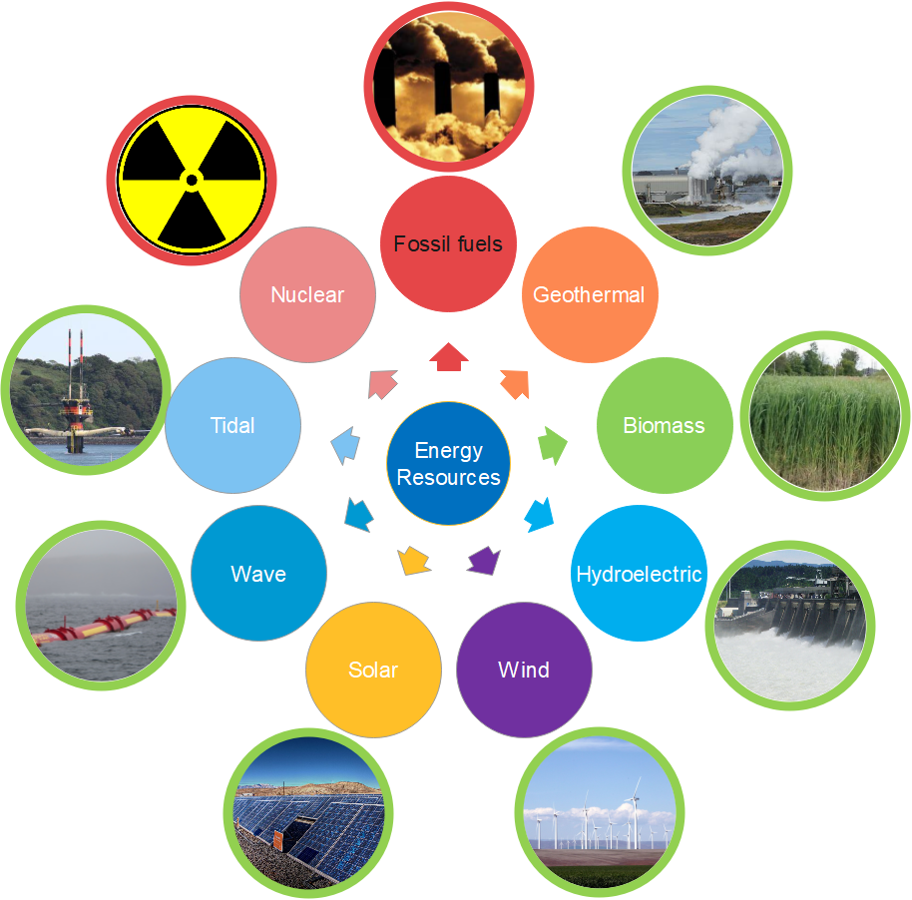
Figure 1: The different types of energy resources available; the images circled in red are non-renewable and the images in green are renewable sources
Non-renewable sources of energy
Fossil fuels are a chemical store of energy and include coal, oil, and natural gas. Most of South Africa’s electricity is produced by burning fossil fuels, mainly coal ([latex]\scriptsize \displaystyle 90\%[/latex]).
Oil
As we learnt in level 4 subject outcome 5.4 unit 4, [link to: L4 SO 5.4 Unit 4] crude oil is separated by fractional distillation and used to make the fuels petrol and diesel for cars, trucks, and motorbikes. It can be used to generate electricity, although its use as an energy source is in decline.
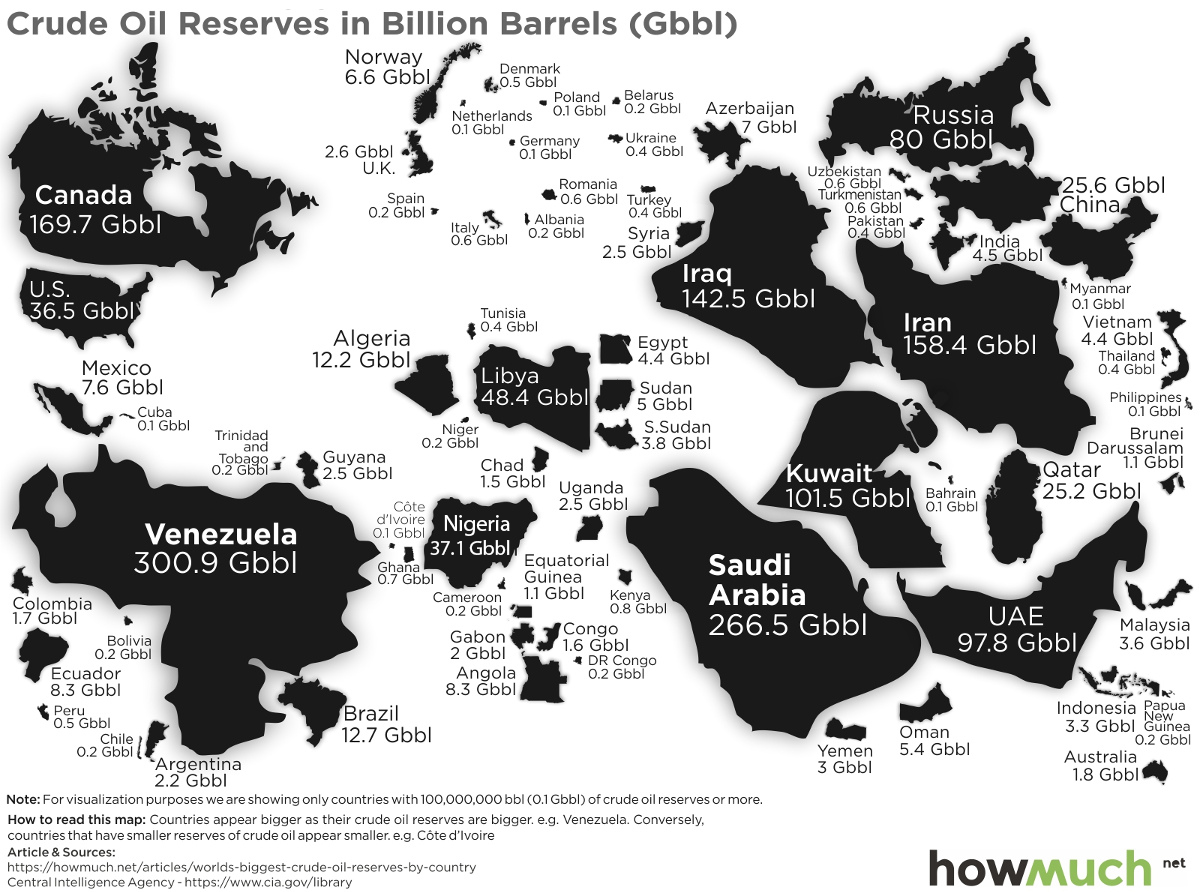
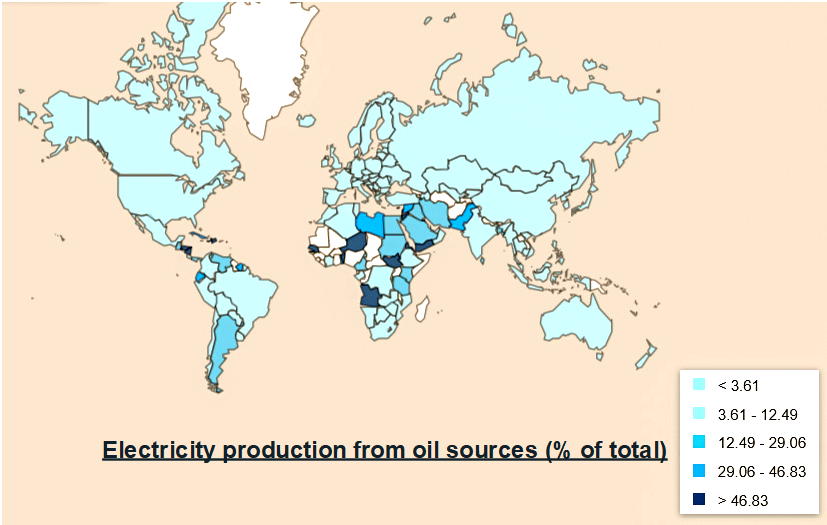
Three technologies are used to convert oil into electricity:
- Conventional steam – Oil is burned to heat water to create steam to generate electricity.
- Combustion turbine – Oil is burned under pressure to produce hot exhaust gases which spin a turbine to generate electricity.
- Combined-cycle technology – Oil is first combusted in a combustion turbine, using the heated exhaust gases to generate electricity. After these exhaust gases are recovered, they heat water in a boiler, creating steam to drive a second turbine.
Environmental impacts
Burning oil for electricity pollutes the air, water, and land but some of the worst environmental woes associated with oil are linked to drilling, transporting, and refining.
Burning oil to generate electricity produces significant air pollution in the forms of nitrogen oxides, and, depending on the sulfur content of the oil, sulfur dioxide and particulates. Carbon dioxide and methane (as well as other greenhouse gases), heavy metals such as mercury, and volatile organic compounds (which contribute to ground-level ozone) can be released into the atmosphere from the smokestack of an oil-burning power plant.
The operation of oil-fired power plants also impacts water, land use and solid waste disposal. Like the operations of other conventional steam technologies, oil-fired conventional steam plants require large amounts of water for steam and cooling and can negatively impact local water resources and aquatic habitats. Sludge and oil residue that are not consumed during combustion become solid waste and contain toxic and hazardous materials.
Drilling also produces a long list of air pollutants, toxic and hazardous materials, and emissions of hydrogen sulfide, a highly flammable and toxic gas. All these emissions can impact the health and safety of workers and wildlife. Loss of huge stretches of wildlife habitat also occur during drilling. Refineries, too, spew pollution into the air, water, and land (in the form of hazardous wastes). Oil transportation accidents can result in catastrophic damage killing thousands of fish, birds, other wildlife, plants, and the contamination of soil.
Take note!
What is a megawatt?
[latex]\scriptsize 1\text{ MW = 1 000 KW}[/latex]
[latex]\scriptsize \displaystyle 1[/latex] MW is enough energy to run a pool pump for [latex]\scriptsize \displaystyle 5[/latex] months or make [latex]\scriptsize \displaystyle 90\text{ }000[/latex] pieces of toast.
Crude oil is a non-renewable energy source because it takes millions of years to produce crude oil and so we cannot produce more when the existing reserves are finished.
Coal
Coal has traditionally dominated the energy supply sector in South Africa, from as early as 1880 when coal from the Vereeniging area was supplied to the Kimberly diamond fields.
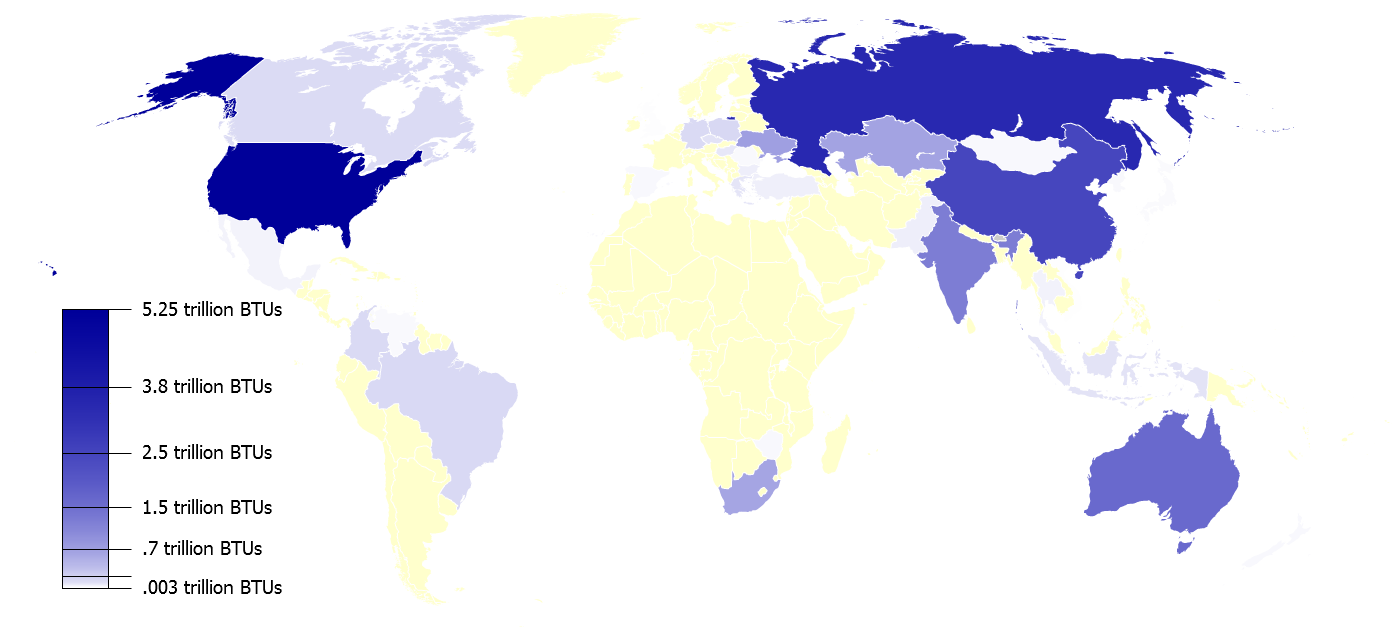
South Africa produces an average of [latex]\scriptsize \displaystyle 224[/latex] million tons of coal annually, making it the fifth largest coal producing country in the world. South Africa’s coal reserves are estimated at [latex]\scriptsize \displaystyle 53[/latex] billion tonnes, and with our present production rate there should be almost 200 years of coal supply left.
Producing electricity from coal starts when the coal is pulverised in huge mills into a fine powder before it is blown into huge kettles, called boilers. Due to the heat in the boiler, the coal particles combust and burn to generate heat to turn water into steam. The steam from the boilers is used to turn the blades of a giant fan or propeller, called a turbine. The turbine turns a coil made of copper wire (the rotor) inside a magnet (the stator). Together they make up the generator. The generator produces an electric current, which is sent to the homes and factories of consumers via power lines.
The advantages of coal
Coal has several advantages when it comes to producing energy.
- Reliability. One of the greatest advantages of coal fired power plants is reliability. Coal’s ability to supply power during peak power demand either as base power or as off-peak power is greatly valued as a power plant fuel. Advanced pulverised coal fired power plants are designed using this feature to support the grid system in avoiding blackouts.
- Affordability. Energy produced from coal fired plants is cheaper and more affordable than other energy sources. Since coal is abundant, it is cheap to produce power using this fuel. Moreover, it is not expensive to extract and mine from coal deposits. Consequently, its price remains low compared to other fuel and energy sources.
- Abundance. There are approximately over 300 years of economic coal deposits still accessible globally. With this great amount of coal available for use, coal fired plants can be continuously fuelled for many years to come.
- Known technologies. The production and use of coal as a fuel are well understood, and the technology required in producing it is constantly advancing.
- Safety. Generally, coal fired plants are considered safer than nuclear power plants. A coal power plant’s failure is certainly not likely to cause catastrophic events such as a nuclear meltdown would. Additionally, the welfare and productivity of coal industry employees has greatly improved over the years.
The disadvantages of coal
On the other hand, there are also some significant disadvantages of coal fired plants including greenhouse gas (GHG) emissions, mining destruction, generation of millions of tons of waste, and the emission of harmful substances.
- Greenhouse gas emissions. The by-products of combustion cause a lot of pollution and contribute to global warming. The increased carbon emissions by coal fired plants has led to further global warming which results in climate change.
- Mining destruction. Mining of coal not only results in the destruction of habitat and scenery, but it also displaces humans as well. In many countries where coal is actively mined, many people are displaced in huge numbers due to the pitting of the earth brought about by underground mining. Places near coal mines are unsafe for human habitation as the land could cave in at any time.
- Generation of millions of tons of waste. These waste products contribute to waste disposal problems and also contain harmful substances.
- Emission of harmful substances. These include mercury, sulfur dioxide, carbon monoxide, mercury, selenium, and arsenic. These harmful substances not only cause acid rain but also are very harmful to humans as well.
Gas
Natural gas power plants generate electricity by burning natural gas as their fuel. There are many types of natural gas power plants which all generate electricity but serve different purposes. All natural gas plants use a gas turbine; natural gas is added, along with a stream of air, which combusts and expands through this turbine causing a generator to spin a magnet, making electricity.
South Africa currently generates [latex]\scriptsize \displaystyle 5\%[/latex] of its total electricity using gas from seven plants located mainly in the Western Cape. The newest plant is the [latex]\scriptsize \displaystyle 140\text{ MW}[/latex] plant located at Sasolburg.
South Africa has no natural gas reserves and all the natural gas used is imported.
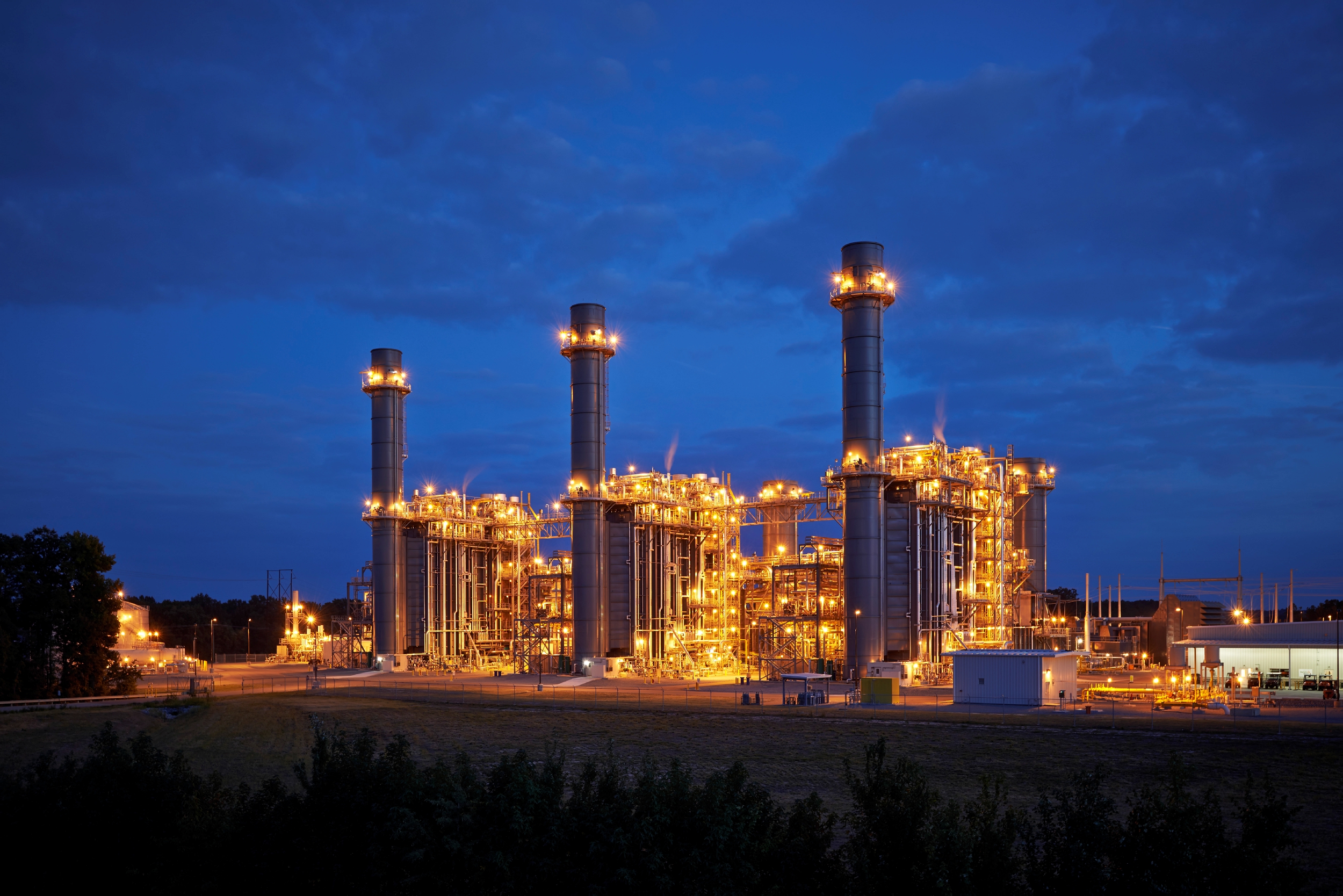
Natural gas power plants are cheap and quick to build. They also have very high thermodynamic efficiencies compared to other power plants. Burning of natural gas produces fewer pollutants like [latex]\scriptsize \displaystyle \text{N}{{\text{O}}_{\text{x}}}\text{, S}{{\text{O}}_{\text{x}}}[/latex] and particulate matter than coal and oil.
On the other hand, natural gas plants have significantly higher emissions than a nuclear power plant, but air quality tends to improve (i.e. reduction in smog) when switching to natural gas plants from coal plants.
Natural gas plants significantly contribute to climate change, and that contribution is growing. Natural gas power plants produce considerable carbon dioxide, although less than coal plants do. Also, the process of getting natural gas from where it is mined to the power plants leads to a considerable release of methane (natural gas that leaks into the atmosphere). If natural gas plants are used to produce electricity their emissions will continue to warm the planet in dangerous ways.
Nuclear power
South Africa is among the top countries in the world with uranium reserves, and accounts for a significant reserve base of an estimated [latex]\scriptsize \displaystyle \text{279 100 tonnes}[/latex] of uranium, or around [latex]\scriptsize \displaystyle \text{5}\text{.2 }\!\!%\!\!\text{ }[/latex] of proven global reserves.
Uranium is used in a nuclear power station to produce energy, which contributes about [latex]\scriptsize \displaystyle 3\%[/latex] of the total energy supply in South Africa. All the uranium used at the Koeberg Power Station is produced locally. As mentioned in level 3 subject outcome 7.1 unit 2, South Africa has one nuclear power plant located in the Western Cape. A new plant located in Thyspunt in the Eastern Cape has been approved as of September 2021.
The disadvantages of nuclear energy
There are however, several disadvantages of using nuclear power.
- Environmental impact: The process of mining and refining uranium is not clean. Transporting nuclear fuel to and from plants involves a pollution hazard. Also, once the fuel is used, you can’t simply take it to the landfill – it is radioactive and dangerous.
- Radioactive waste disposal: As a rule, a nuclear power plant creates 20 metric tons of nuclear fuel per year, and a large amount of nuclear waste. The biggest part of this waste emits radiation and heat, meaning that it will decay any compartment that holds it. It can also cause damage to living things in and around the plants.
.
Nuclear power plants create a lot of low-level radioactive waste. Over time, used nuclear fuel decays to safe radioactive levels, however, this takes a countless number of years. Even low-level radioactive waste takes hundreds of years to achieve adequate levels of safety. South Africa’s radioactive waste is currently stored in the Kalahari Desert. - Nuclear accidents: The worst nuclear accident to date was the Chernobyl disaster which occurred in 1986 in Ukraine. The accident killed [latex]\scriptsize \displaystyle 31[/latex] people directly and damaged approximately [latex]\scriptsize \displaystyle 7[/latex] billion dollars’ worth of property. Radioactive fallout from the accident was concentrated in areas of Belarus, Ukraine, and Russia. Studies have estimated as many as over a million eventual cancer deaths from Chernobyl. To date, Chernobyl remains a closed off area.
.
The most recent nuclear disaster was the Fukushima Daiichi nuclear disaster in 2011 in Japan. The cause of the disaster was an earthquake and tsunami. It was the most severe nuclear accident since the Chernobyl disaster.
.
On detecting the earthquake, the active reactors automatically shut down their normal power-generating fission reactions. Because of these shutdowns and other electrical grid supply problems, the reactors’ electricity supply failed, and their emergency diesel generators automatically started. However, the earthquake had also generated a tsunami [latex]\scriptsize \displaystyle 14[/latex] metres high that arrived shortly afterwards and swept over the plant’s seawall and then flooded the lower parts of the reactors. This flooding caused the failure of the emergency generators and loss of power to the circulating pumps. The resultant loss of reactor core cooling led to three nuclear meltdowns, three hydrogen explosions, and the release of radioactive contamination.
.
The government declared an evacuation zone around the plant, with a [latex]\scriptsize \displaystyle 20\text{ }[/latex] km radius, and almost [latex]\scriptsize \displaystyle 200\text{ }000[/latex] residents were evacuated, large amounts of water contaminated with radioactive isotopes were released into the Pacific Ocean during and after the disaster. - High cost: The initial costs for building a nuclear power plant are steep. South Africa scrapped plans to add [latex]\scriptsize \displaystyle 9.6\text{ GW}[/latex] of nuclear power to its energy mix due to the cost, which was estimated anywhere between [latex]\scriptsize \displaystyle \$34-84[/latex] billion (approximately [latex]\scriptsize \text{R}476[/latex] billion – [latex]\scriptsize \text{R}1.76[/latex] trillion). The nuclear plants are cheap to run and produce inexpensive fuel, but the initial costs are huge.
- Uranium is finite: Unlike fossil fuels that are available to most of the countries, uranium is a very scarce resource and exists in only a few countries. Typical renewable energy sources such as solar and wind are in infinite supply. Uranium is in limited supply and, although currently abundant, there is still the risk of running out eventually.
The advantages of nuclear energy
There still remain some advantages of using nuclear power.
- Low pollution: Nuclear power creates fewer greenhouse emissions. It has been determined that the number of greenhouse gases have decreased by almost half because of the use of nuclear power. This avoids more than [latex]\scriptsize \displaystyle 470[/latex] million metric tons of carbon each year, which is the equivalent of removing [latex]\scriptsize \displaystyle 100[/latex] million cars off the road. Nuclear energy has the least effect on nature since it doesn’t discharge any gasses such as methane and carbon dioxide, which are the primary ‘greenhouse gasses’.
.
Nuclear advocacy group the World Nuclear Association found that the average emissions for nuclear are [latex]\scriptsize \displaystyle 29[/latex] tonnes of [latex]\scriptsize \displaystyle \text{C}{{\text{O}}_{\text{2}}}[/latex] per gigawatt-hour (GWh) of energy produced. This compares favourably with renewable sources like solar and wind and even more favourably with fossil fuels like coal ([latex]\scriptsize \displaystyle 888[/latex] tonnes per GWh). - High power output: It has the capacity to meet city and industrial needs with just one reactor. A relatively small amount of uranium can be used to fuel a [latex]\scriptsize \displaystyle 1\text{ }000[/latex] megawatt electric plant and provide enough electricity to power a city of about half a million people.
- Stable base load energy: This means that it can be used in conjunction with other forms of renewable energy. For example, when the wind is blowing, nuclear plants can adjust energy output to be lower. Conversely, when the wind is not blowing, and greater energy is needed, nuclear energy can be adjusted to compensate for the lack of wind (or solar) generated power.
- Low operating costs: Nuclear power produces very inexpensive electricity and is cheaper than gas, coal, or any other fossil fuel plants. The cost of the uranium is low.
- Reliability: It is estimated that with the current rate of consumption of uranium, we have enough uranium for another [latex]\scriptsize \displaystyle 70-80[/latex] years. As solar and wind energy are dependent upon weather conditions, the nuclear power plant has no such constraints and can run without disruption in any climatic condition.
- More proficient than fossil fuels: The amount of fuel required by the nuclear power plant is comparatively less than what is required by other power plants, as the energy released by nuclear fission is approximately ten million times greater than the amount of energy released by fossil fuels per atom.
- Not reliant on fossil fuels: Coal and natural gas power plants discharge carbon dioxide into the air, which causes several environmental issues. With nuclear power plants, carbon emissions are insignificant.
- Potential for an alternative: Nuclear energy is not a renewable resource. Uranium is limited and cannot be produced again and again on demand. Thorium is a alternative that has recently been identified as a nuclear fuel. China, Russia, and India already have plans to start using thorium to fuel their reactors soon.
- Economic impact: Nuclear power provides many benefits to the economy with the number of jobs and the prosperity a new plant brings.
Exercise 1.1
- Give one advantage and one disadvantage of using nuclear energy to generate electricity.
- List two disadvantages, excluding acid rain, of a heavy reliance on fossil fuels to produce electricity.
- Give three reasons why South Africa is dependent on coal to generate most of its electricity.
The full solutions are at the end of the unit.
Renewable sources of energy
South Africa is regarded as a prime candidate for increased use of renewable energy with its abundant natural resources of sun and wind. The country is highly dependent on burning coal for power generation at the moment, but at the same time South Africa has an abundance of sunshine which lends itself very well to solar water heating and electricity generation.
Given the ever-rising cost of traditional fossil fuels-based energy, renewable energy is becoming a viable option. The Renewable Energy Independent Power Producers Procurement Programme (REIPPPP) has to date, attracted investment to the value of [latex]\scriptsize \displaystyle \text{R209}\text{.7 }\!\!~\!\!\text{ billion }\!\!~\!\!\text{ }[/latex].
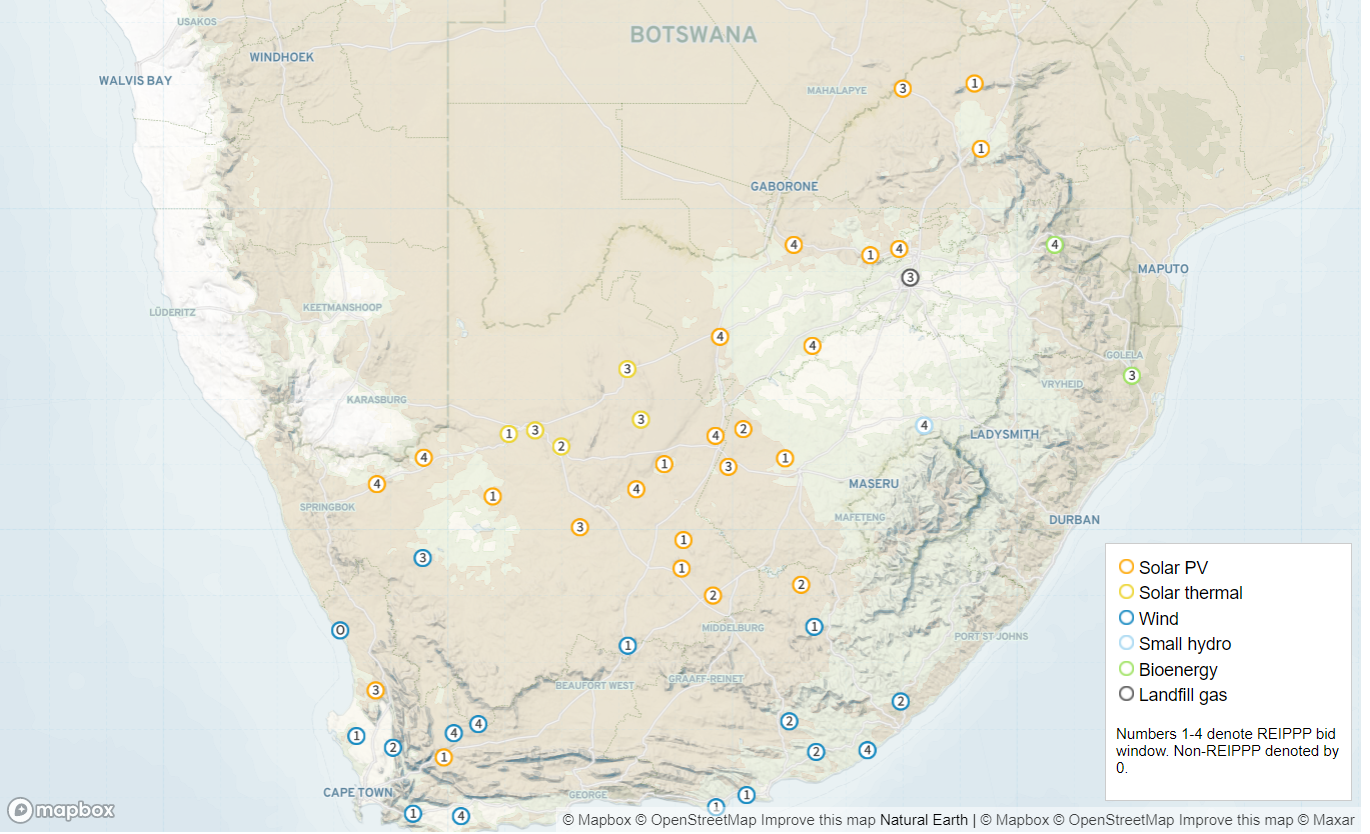
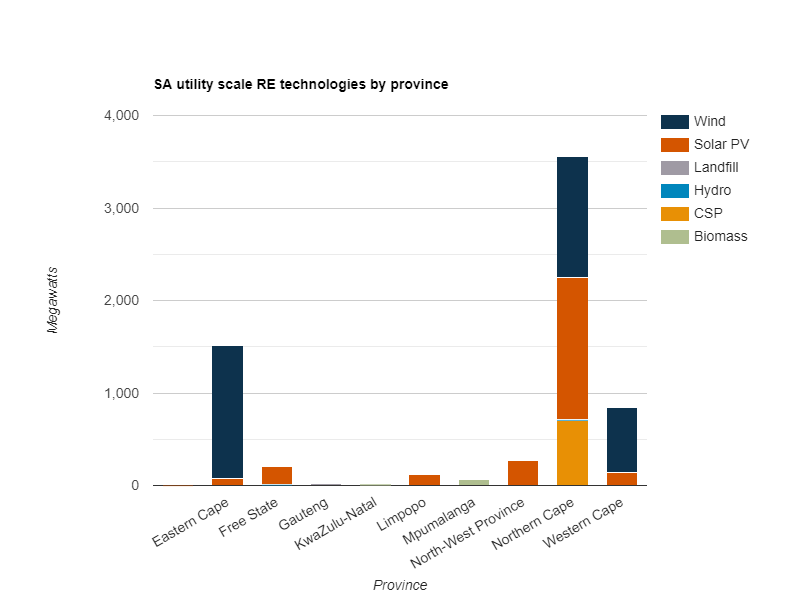
The current new capacity projections include [latex]\scriptsize \displaystyle 14\text{ }725[/latex] MW of renewable energy, comprising of solar PV ([latex]\scriptsize \displaystyle 6\text{ }225[/latex] MW), wind ([latex]\scriptsize \displaystyle 6\text{ }360[/latex] MW), concentrated solar power (CSP) ([latex]\scriptsize \displaystyle 1\text{ }200[/latex] MW), small hydro ([latex]\scriptsize \displaystyle 195[/latex] MW), biomass ([latex]\scriptsize \displaystyle 210[/latex] MW), biogas ([latex]\scriptsize \displaystyle 110[/latex] MW).
Wind farms in South Africa
Winds are caused by the rotation of the earth, heating of the atmosphere by the sun, and the earth’s surface irregularities. We can harness wind energy and use it to generate power if the sun shines and the wind blows.
Wind turbines are a relatively simple system of generating electricity and have not changed much over the centuries. As the wind rotates the blades – which face into the wind and are tilted to generate the greatest rotation – the blades rotate a shaft and a generator, which turn the energy into electricity. Modern wind turbines will also have sensors which detect the direction and power of the wind, so they can be rotated toward the wind or shut down if the wind is too low, or too powerful.
Crucially, electrical energy is lost if it is transported great distances, so the closer the wind farms are to the grid, the more efficient they become.
South Africa has thirty-six winds farms which are fully operational or under construction. The majority are in the Eastern Cape.
These projects form part of the REIPPP programme, which aims to procure [latex]\scriptsize \displaystyle 17\text{ }800[/latex] MW of renewable energy capacity by 2030.
Wind is a renewable resource with wind farms having a virtually non-existent carbon footprint once the turbines have been constructed.
The advantages of wind farms
Wind farms have a number of advantages:
- Wind energy is a clean source of power: Wind does not pollute the air or require any destructive chemicals. As a result, wind energy lessens our reliance on fossil fuels.
- Renewable source: The wind is limitless.
- Wind energy has low operating costs: The wind farms or individual turbines can be expensive to install. However, once installed and running, operating costs are relatively low; fuel (wind) is free, and the turbines don’t require too much maintenance over the course of their life.
- Prices are decreasing: Prices of turbines have decreased by over [latex]\scriptsize \displaystyle 80\%[/latex] since 1980. Thanks to technological advancements and increased demand, prices are expected to keep decreasing in the foreseeable future.
- Wind farms can be built on existing farms: Wind turbines are incredibly space-efficient and can be installed on existing farms or agricultural land in rural areas where they can be a source of income for the farmers as wind plant owners make payments to farmers for the use of their land for electricity generation.
- Conserves and keeps water clean: Turbines produce no particulate emissions that contribute to mercury contamination in our lakes and streams. Wind energy also conserves water resources. For producing the same amount of electricity, nuclear power takes about [latex]\scriptsize \displaystyle 600[/latex] times more water than wind, and coal takes about [latex]\scriptsize 500[/latex] times more water than wind.
The disadvantages of wind energy
Wind farms also have a number of disadvantages:
- Wind reliability: Wind does not generally blow reliably.
- Wind turbines could be a threat to wildlife: The edges of wind turbines can be unsafe for wildlife, especially birds and other flying creatures that may be in the area.
- Wind turbines could lead to noise and visual pollution.
- Expensive to set up: The manufacturing and installation of wind turbines require heavy upfront investments.
- Wind power can be harnessed at certain locations only: Wind energy can only be harnessed at certain locations where the speed of the wind is high. Since they are mostly set up in remote areas, transmission lines must be built to bring the power generated to cities, which requires extra investment to set up the infrastructure.
- Effect on the environment: Wind farms need wide open areas to set up wind turbines and some believe they are an eyesore.
Solar power
Solar power in South Africa includes photovoltaics (PV) as well as concentrated solar power (CSP). In 2016, South Africa had [latex]\scriptsize \displaystyle 1\text{ }329[/latex] MW of installed solar power capacity. Installed capacity is expected to reach [latex]\scriptsize \displaystyle 8\text{ }400[/latex] MW by 2030. South Africa currently has 55 solar farms, and an increasing number of private individuals are installing solar panels on the roofs of their houses and businesses.
South Africa is fortunate in the amount of sunlight it receives every day. Solar energy can be regarded as one of the cleanest and greenest energy sources that is sufficiently developed to deliver significant amounts of electricity. The largest solar farm located in De Aar is the largest solar power plant located in the Southern hemisphere and the Middle East. The entire solar farm facility is spread over a surface of almost [latex]\scriptsize 100[/latex] hectares and consists of 700 000 solar panels, delivering [latex]\scriptsize 50[/latex] MW. On very sunny days, the power plant produces much more power than the grid demands, so the excess energy goes to waste as it cannot be stored.
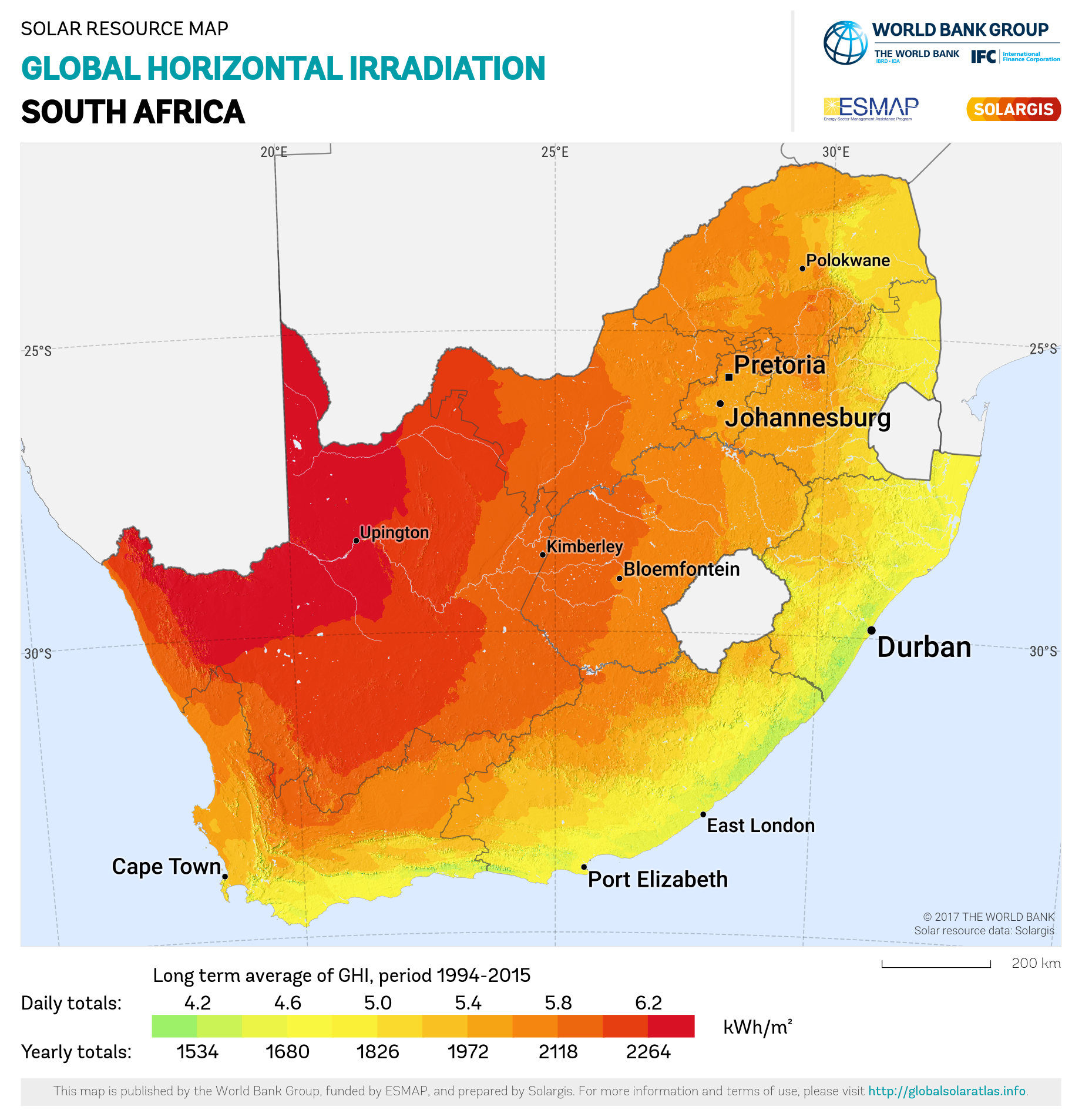
South Africa’s solar farms employ one of two methods to harness the sun’s energy:
- Photovoltaics (Solar PV) is a form of active solar technology that was discovered in 1839 by 19-year-old French physicist Alexandre-Edmond Becquerel. Becquerel discovered that when he placed silver-chloride in an acidic solution and exposed it to sunlight, the platinum electrodes attached to it generated an electric current. This process of generating electricity directly from solar radiation is called the photovoltaic effect, or photovoltaics.
.
Photovoltaic arrays usually involve solar panels, a collection of dozens or even hundreds of solar cells. Each solar cell contains a semiconductor, usually made of silicon. When the semiconductor absorbs sunlight, electrons become free to move. An electrical field directs these free electrons forming an electric current, flowing in one direction. Metal contacts at the top and bottom of a solar cell direct that current to an external object. The external object can be as small as a solar-powered calculator or as large as a power station.
.
Photovoltaic technology can also be installed on a smaller scale. Solar panels and cells can be fixed to the roofs or exterior walls of buildings, supplying electricity for the structure.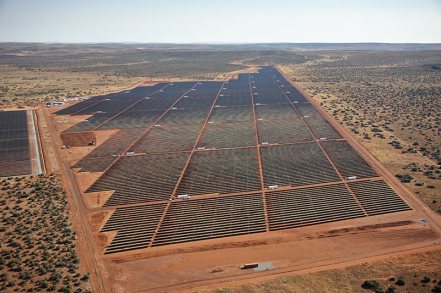
Figure 9: Jasper solar farm, made up of 25 000 photovoltaic modules, is outside Kimberley in the Northern Cape - Concentrated Solar Power (CSP). CSP technology uses lenses and mirrors to concentrate sunlight from a large area into a much smaller area. This intense area of radiation heats a fluid, which in turn generates electricity or fuels another process.
.
Solar power towers use heliostats, flat mirrors that turn to follow the sun’s arc through the sky. The mirrors are arranged around a central ‘collector tower’, and reflect sunlight into a concentrated ray of light that shines on a focal point on the tower.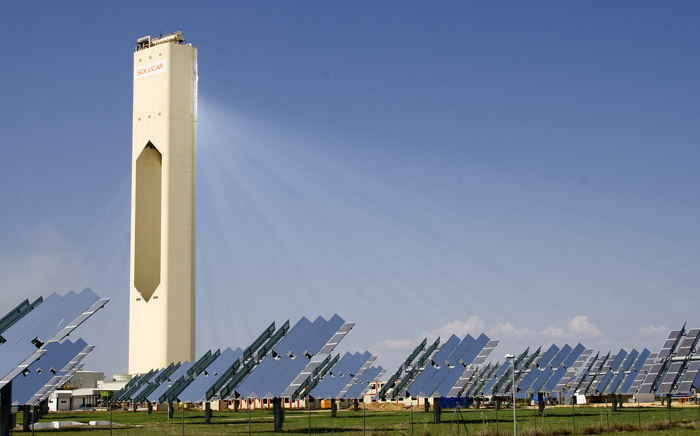
Figure 10: A CSP plant 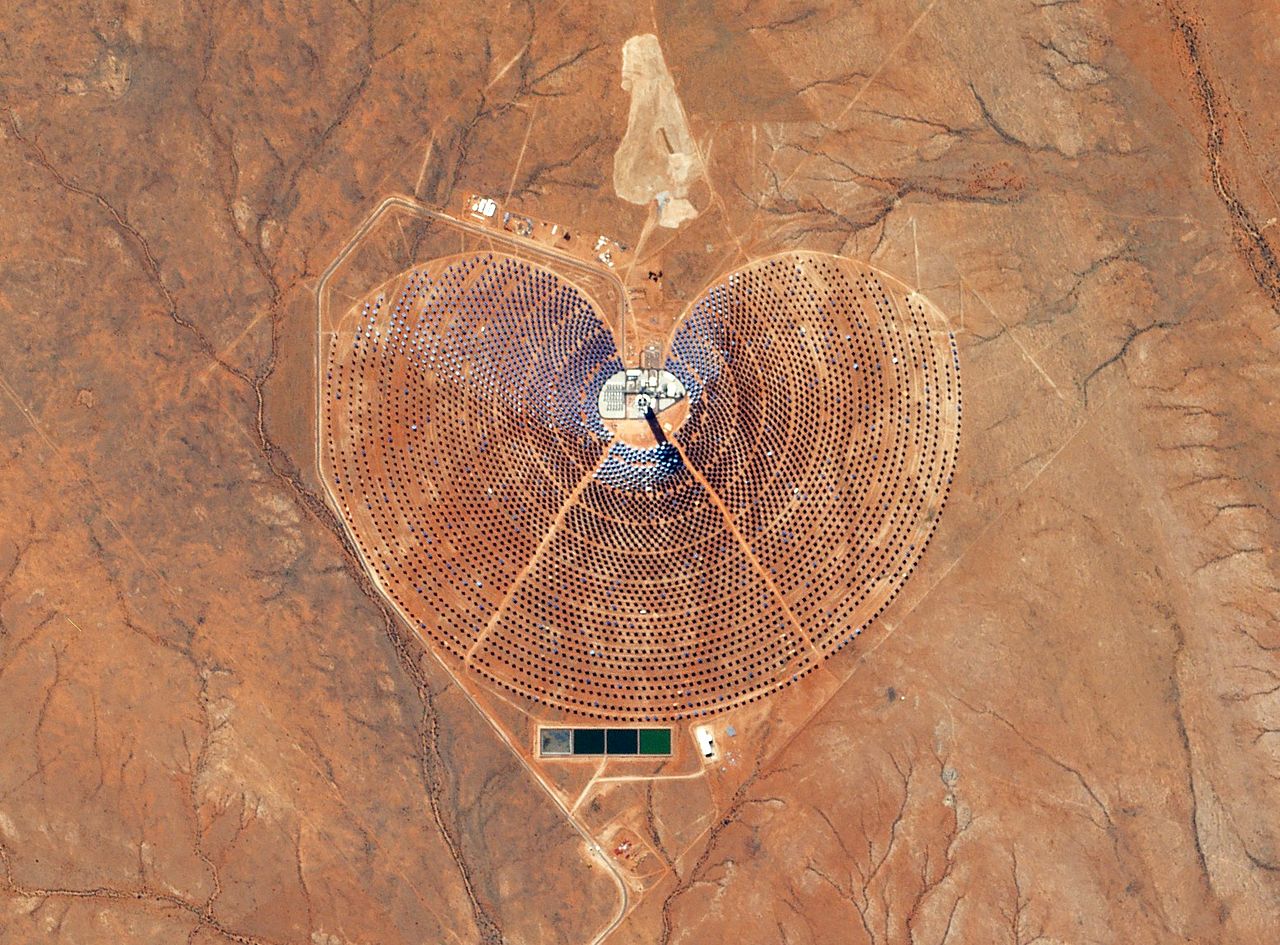
Figure 11: Khi Solar One (KSO) is a solar power tower thermal power plant, located in the Northern Cape; Khi Solar One provides [latex]\scriptsize \displaystyle 50[/latex] megawatts (MW) and is the first solar power plant in Africa, it covers an area of [latex]\scriptsize \displaystyle 140[/latex] hectares. .
Construction of South Africa’s largest renewable energy project to date – the Redstone concentrated solar power (CSP) plant – commenced in August 2021. The R[latex]\scriptsize \displaystyle 11.6[/latex] billion solar farm is being built near Postmasburg in the Northern Cape, close to the Jasper and Lesedi photovoltaic (PV) plants and will have a generating output capacity of [latex]\scriptsize \displaystyle 100[/latex] MW. While this is less than the current largest solar power plant in South Africa – the De Aar project in the Northern Cape – it comes equipped with a 12-hour thermal storage system. This makes it capable of consistently delivering electricity to almost 200 000 households, double the number powered by the De Aar plant. The solar plant is expected to reduce an estimated [latex]\scriptsize \displaystyle 440[/latex] metric tons of [latex]\scriptsize \displaystyle \text{C}{{\text{O}}_{\text{2}}}[/latex] emissions per year.
The advantages of solar energy
There are many advantages to solar energy:
- Stable price levels compared to other energy sources: Many energies, especially those that rely on fossil fuels, are expensive since a price is usually determined by supply and demand.
- Cost per energy unit is zero after one-time investment: Solar energy is free. Apart from the upfront cost for the installation of the solar panels and the storage, energy can be produced with no extra cost.
- Solar energy is a renewable energy source.
- Solar power is available all year long and can be stored: Although solar power cannot be produced every day due to clouds or rainfalls, the supply of energy can be assured by using energy storage. By doing so, the energy that is produced during sunny days can be stored for use on days with no sunshine or at night.
- Solar energy will likely become even cheaper in the future: Even though there has already been plenty of research in the field of solar energy, it is likely that technological progress will continue, and this will likely also lead to a decrease in prices for solar panels and batteries for storage.
- Low maintenance costs: Since solar panels are quite durable on average, the maintenance costs are quite low.
- Solar power can be regarded as quite ecologically friendly: Apart from the initial production of solar panels and of solar energy storage, there is virtually no additional pollution associated with the generation of solar energy.
The disadvantages of solar energy
There are however some disadvantages of solar energy:
- Initial production of solar panels produces significant pollution: Although there are no direct environmental costs once the solar panels are set up, the initial installation and production of the solar panels requires the use of precious resources and contributes to several kinds of pollution.
- High upfront costs of solar panels: The upfront costs of solar panels can be quite high at present, as are the batteries needed to store energy.
- Sun intensity varies over the year: Depending on the region, there might be many days or even weeks with rain or clouds and solar energy panels will not be able to generate sufficient electricity.
- Solar farms need large areas of land: For solar farms, large areas of land must be used, which in turn often leads to the destruction of habitats for a variety of animals and plants.
Hydroelectricity
Hydroelectric energy is a form of energy that harnesses the power of water in motion—such as water flowing over a waterfall—to generate electricity.
Most types of hydroelectric power plants have a reservoir of water, a gate or valve to control how much water flows out of the reservoir, and an outlet or place where the water ends up after flowing downward. Water has gravitational potential energy just before it spills over the top of a dam or flows down a hill. The gravitational potential energy is converted into kinetic energy as water flows downhill. The water can be used to turn the blades of a turbine to generate electricity, which is distributed to the power plant’s customers.
There are three different types of hydroelectric energy plants, the most common being an impoundment facility. In an impoundment facility, a dam is used to control the flow of water stored in a pool or reservoir. When more energy is needed, water is released from the dam. Once water is released, gravity takes over and the water flows downward through a turbine. As the blades of the turbine spin, they power a generator.
Another type of plant is called a pumped-storage facility. This plant collects the energy produced from solar, wind, and nuclear power and stores it for future use. The plant stores energy by pumping water uphill from a pool at a lower elevation to a reservoir located at a higher elevation. When there is high demand for electricity, water located in the higher pool is released. As this water flows back down to the lower reservoir, it turns a turbine to generate more electricity.
Eskom has three types of hydroelectric power stations; conventional reservoir – Gariep and Vanderkloof, run-of-river – Colley Wobbles, First and Second Falls and Ncora, and pumped storage schemes – Palmiet, Drakensberg and Ingula.
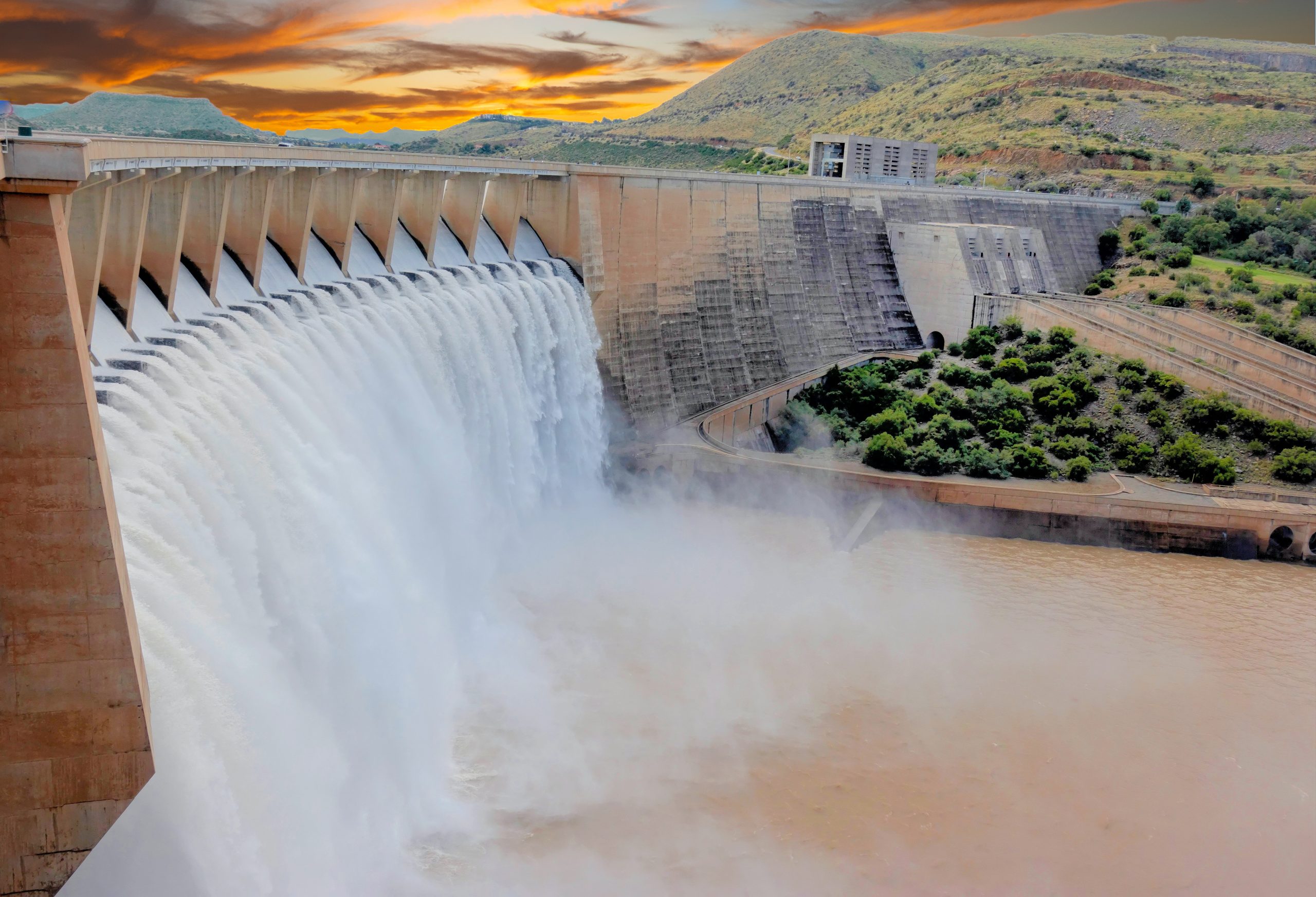
The advantages of hydroelectricity
There are various advantages of hydroelectricity:
- It is incredibly cheap: Once a power plant goes live and the construction has been completely paid, hydroelectricity is cheaper than all other renewable sources.
- There is a constant source of power: Hydroelectricity is always being produced because water is always flowing.
- It is a flexible source of power: Many hydroelectricity plants can adapt to changing electrical needs. All they must do is release more water during high periods of electricity demand and fill up the reservoir being maintained during periods of low electricity use. Even on the hottest or coldest days of the year, almost every hydroelectricity plant can meet the demand because of this.
- They add recreational opportunities: Most hydroelectricity plants are based in a dam system on a moving body of water. This means that the reservoir behind the dam must build up for peak use periods and this creates a lake that local communities can use. Beaches, water sports, camping, swimming, and even fishing all become possible – and a potential source of new revenues.
- Hydroelectricity plants are highly scalable: Almost every power plant that generates electricity by water flow can be built with a small initial capacity and then be scalable to fit the ongoing needs of the community.
- Hydroelectricity helps fight climate changes and improves air quality: The hydroelectric life cycle produces very small amounts of greenhouse gases. Although only [latex]\scriptsize 33 \%[/latex] of the available hydroelectric potential has been developed, today hydroelectricity prevents the emission of greenhouse gases corresponding to the burning of [latex]\scriptsize \displaystyle 4.4[/latex] million barrels of petroleum per day worldwide. Hydroelectric power plants do not release pollutants into the air.
The disadvantages of hydroelectricity
There remain some disadvantages of hydroelectricity:
- Drought conditions can greatly affect output – or eliminate it: If the water dries up, then so does the ability to generate power.
- It alters the natural movements of nature: Although modern technology allows for hydroelectric plants to accommodate wildlife movement as much as possible, using salmon runs or alternative migration paths, it is not a perfect system. The filling of a reservoir destroys the habitats of certain animal species, no matter how careful the construction efforts might be.
- They often have a high initial cost: Although the ongoing maintenance costs of hydroelectric power are quite minimal, the initial costs of building a plant require a high level of capital.
- Animals are not the only creatures that need to relocate: Once a dam is installed and the reservoir begins to fill up, there may be people that need to be relocated to new areas as well.
- There are limited places for reservoir development: Many nations have already begun to use up the prime locations for reservoir development that can sustain an ongoing hydroelectric plant.
- Impacts further downstream: The formation of a dam can also have severe impacts on habitats downstream. When the natural flow of a river is blocked so is that of the sediments and nutrients contained within the water. These sediments and nutrients are often vital for replenishing downstream ecosystems such as wetlands, flood plains and deltas. This can lead to the disappearance of birds and other species.
.
The stagnant reservoir of a hydroelectric dam is often much colder and lower in dissolved oxygen levels. As this water is released through a hydroelectric dam it can alter the temperature and oxygen levels of the water further downstream resulting in dangerous conditions for fish and other river inhabitants.
.
Sections of river downstream from a hydroelectric dam have the potential to dry out if the flow of water is not managed efficiently. In some countries, hydroelectric power companies are obliged to release set levels of water over the course of the year to mitigate the problem. This careful management can have positive results and reduce the negative impact for habitats and communities further downstream.
.
As water is held back by a dam, the water table can gradually reduce further downstream. This can have disastrous consequences for plants, shrubs, and trees as their roots struggle to absorb enough nutrients from the soil.
Geothermal power
Geothermal energy is the heat produced deep in the Earth’s core. Geothermal energy is a clean, renewable resource that can be harnessed for use as heat and electricity.
Below the Earth’s crust, is the core. A small portion of the core’s heat comes from the friction and gravitational pull formed when Earth was created more than 4 billion years ago. However, most of the Earth’s heat is constantly generated by the decay of radioactive isotopes, such as potassium-[latex]\scriptsize \displaystyle 40[/latex] and thorium-[latex]\scriptsize \displaystyle 232.[/latex]
As potassium-[latex]\scriptsize \displaystyle 40[/latex] decays, its nucleus changes, emitting enormous amounts of energy. Radioactive decay is a continual process in the core. Temperatures there rise to more than [latex]\scriptsize \displaystyle 5\text{ }000\text{ }{}^\circ \text{C}[/latex]. Heat from the core is constantly radiating outward and warming rocks, water, gas, and other geological material.
If underground rock formations are heated to about [latex]\scriptsize \displaystyle 700-1\text{ }300\text{ }{}^\circ \text{C}[/latex], they can become magma. Magma is molten rock permeated by gas and gas bubbles. Magma exists in the mantle and lower crust, and sometimes bubbles to the surface as lava. Magma heats nearby rocks and underground aquifers. Hot water can be released through geysers, hot springs, steam vents, underwater hydrothermal vents, and mud pots.
These are all sources of geothermal energy. Their heat can be captured and used directly for heat, or their steam can be used to generate electricity.
Most of the Earth’s geothermal energy does not bubble out as magma, water, or steam. It remains in the mantle, emanating outward at a slow pace and collecting as pockets of high heat. This dry geothermal heat can be accessed by drilling and enhanced with injected water to create steam.
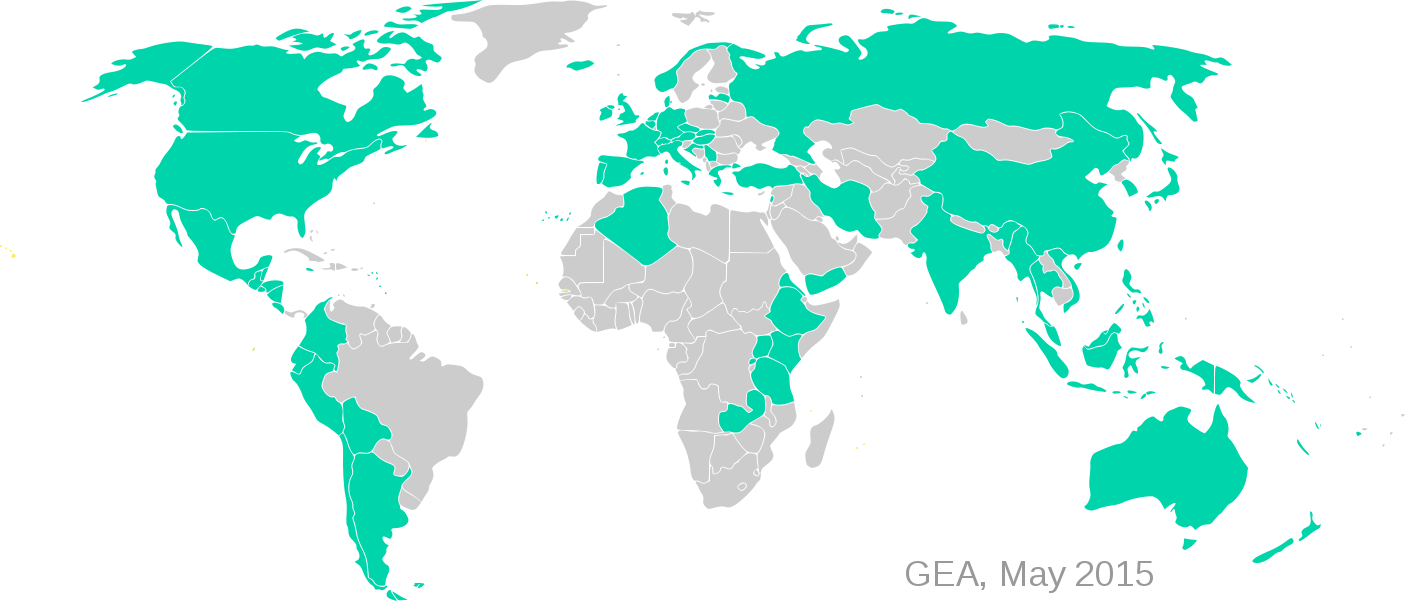
Many countries have developed methods of tapping into geothermal energy. Different types of geothermal energy are available in different parts of the world. In Iceland, abundant sources of hot, easily accessible underground water make it possible for most people to rely on geothermal sources as a safe, dependable, and inexpensive source of energy.
Almost anywhere in the world, geothermal heat can be accessed and used immediately as a source of heat. This heat energy is called low-temperature geothermal energy. Low-temperature geothermal energy is obtained from pockets of heat at about 150 °C. Most pockets of low-temperature geothermal energy are found just a few metres below ground. Low-temperature geothermal energy can be used for heating greenhouses, homes, fisheries, and industrial processes.
Geothermal heat pumps (GHPs) take advantage of the Earth’s heat and can be used almost anywhere in the world. GHPs are drilled about 3 to 90 metres deep, much shallower than most oil and natural gas wells. GHPs do not require fracturing bedrock to reach their energy source.
A pipe connected to a GHP is arranged in a continuous loop that circles underground and above ground, usually throughout a building. The loop can also be contained entirely underground, to heat a parking lot or landscaped area.

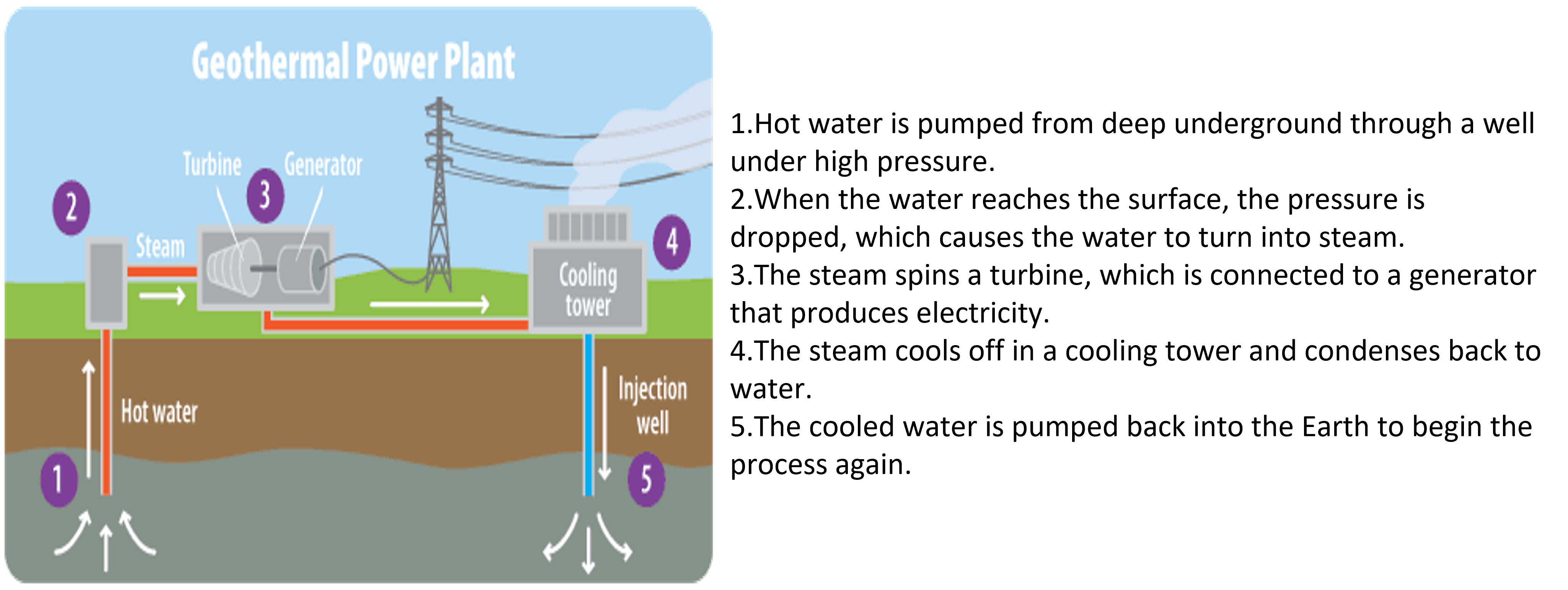
Flash-steam power plants use naturally occurring sources of underground hot water and steam. Water that is hotter than [latex]\scriptsize \displaystyle 182\text{ }{}^\circ \text{C}[/latex] is pumped into a low-pressure area. Some of the water ‘flashes’ or evaporates rapidly into steam, and is funnelled out to power a turbine and generate electricity. Any remaining water can be flashed in a separate tank to extract more energy.
Flash-steam power plants are the most common type of geothermal power plants. The volcanically active island nation of Iceland supplies nearly all its electrical needs through a series of flash-steam geothermal power plants. The steam and excess warm water produced by the flash-steam process heat icy sidewalks and parking lots in the frigid Arctic winter.
Geothermal energy is a renewable resource. The Earth has been emitting heat for about [latex]\scriptsize \displaystyle 4.5[/latex] billion years and will continue to emit heat for billions of years into the future because of the ongoing radioactive decay in the Earth’s core. However, most wells that extract the heat will eventually cool, especially if heat is extracted more quickly than it is given time to replenish. Geothermal systems do not require enormous amounts of freshwater. Because water is only used as a heating agent and is not exposed or evaporated. it can be recycled, used for other purposes, or released into the atmosphere as non-toxic steam.
Geothermal energy exists in different forms all over the Earth (by steam vents, lava, geysers, or simply dry heat), and there are different possibilities for extracting and using this heat.
South Africa does not have any geothermal power plants, but according to a study published in 2016, there is huge potential to develop geothermal power plants.
The advantages of geothermal energy
There are several advantages of using geothermal energy:
- Geothermal energy is renewable; it is not a fossil fuel that will be eventually used up. The Earth is continuously radiating heat out from its core and will continue to do so for billions of years.
- Some form of geothermal energy can be accessed and harvested anywhere in the world. Geothermal power plants can last for decades and possibly centuries. If a reservoir is managed properly, the amount of extracted energy can be balanced with the rock’s rate of renewing its heat.
- Using geothermal energy is relatively clean. Most systems only emit water vapour, although some emit very small amounts of sulfur dioxide, nitrous oxides, and particulates.
- Unlike other renewable energy sources, geothermal systems can work in the summer or winter, and are not dependent on changing factors such as the presence of wind or sun.
- The space it takes to build a geothermal facility is much more compact than other power plants. To produce a GWh, a geothermal plant uses the equivalent of about [latex]\scriptsize \displaystyle 1\text{ }046[/latex] square kilometres of land. To produce the same GWh, wind energy requires [latex]\scriptsize \displaystyle 3\text{ }458[/latex] square kilometres, a solar photovoltaic centre requires [latex]\scriptsize \displaystyle 8\text{ }384[/latex] square kilometres and coal plants use about [latex]\scriptsize \displaystyle 9\text{ }433[/latex] square kilometres.
The disadvantages of geothermal energy
There are also some disadvantages of using geothermal energy:
- The process of injecting high-pressure streams of water into the Earth can result in minor seismic activity, or small earthquakes.
- Geothermal plants have been linked to subsidence, or the slow sinking of land. This happens as the underground fractures collapse upon themselves. This can lead to damaged pipelines, roadways, buildings, and natural drainage systems.
- Geothermal plants can release small amounts of greenhouse gases such as hydrogen sulfide and carbon dioxide. Water that flows through underground reservoirs can pick up trace amounts of toxic elements such as arsenic, mercury, and selenium. These harmful substances can be leaked into water sources if the geothermal system is not properly insulated.
- Although the process requires almost no fuel to run, the initial cost of installing geothermal technology is expensive.
Biomass
Biomass energy is energy generated or produced by living or once-living organisms. The most common biomass materials used for energy are plants, such as corn and soy. This material can be burned to create heat or converted into electricity.
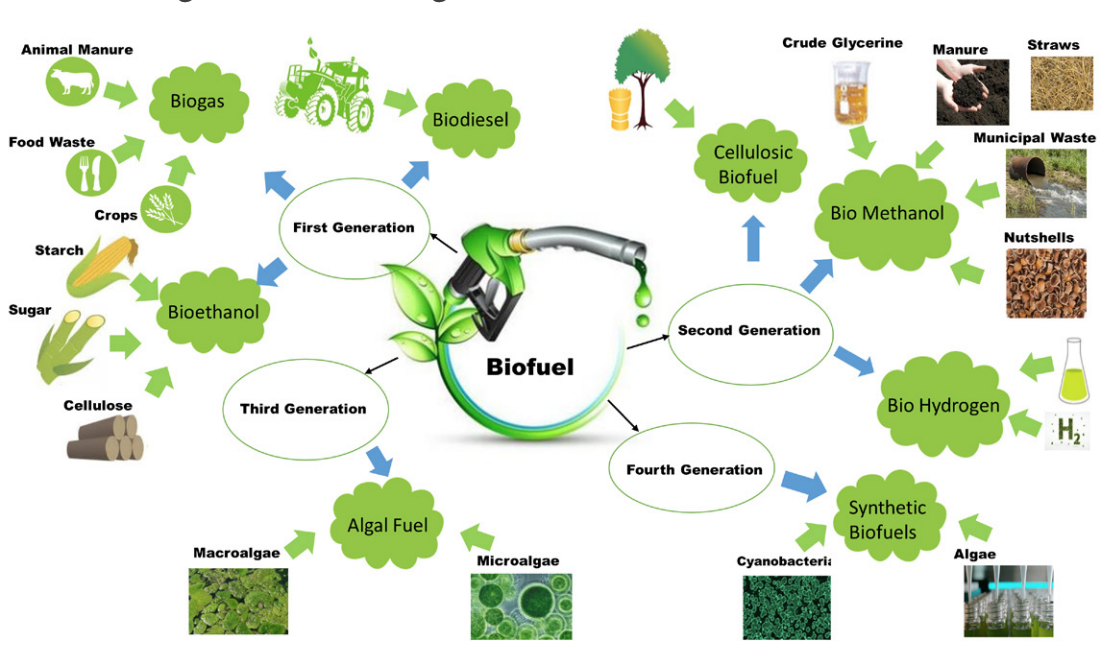
Biomass energy can also be a non-renewable energy source. Biomass contains energy first derived from the sun: plants absorb the sun’s energy through photosynthesis and convert carbon dioxide and water into nutrients (carbohydrates). The energy from these organisms can be transformed into usable energy through direct and indirect means. Biomass can be burned to create heat (direct), converted into electricity (direct), or processed into biofuel (indirect).
Thermal conversion
Biomass can be burned by thermal conversion and used for energy. This involves heating the biomass feedstock to burn, dehydrate, or stabilise it. The most familiar biomass feedstocks for thermal conversion are raw materials such as municipal solid waste (MSW) and scraps from paper or lumber mills.
Before biomass can be burned, however, it must be dried. The biomass dries out so completely that it loses the ability to absorb moisture, or rot. It loses about [latex]\scriptsize \displaystyle 20\%[/latex] of its original mass but keeps [latex]\scriptsize \displaystyle 90\%[/latex] of its energy. During this process, biomass becomes a dry, blackened material. It is then compressed into briquettes. The briquettes have high energy density and are easy to burn during direct or co-firing. Most briquettes are burned directly. The steam produced during the firing process powers a turbine, which turns a generator and produces electricity. This electricity can be used for manufacturing or to heat buildings.
Biomass can also be co-fired or burned with a fossil fuel. Biomass is most often co-fired in coal plants. Co-firing eliminates the need for new factories for processing biomass. Co-firing also eases the demand for coal. This reduces the amount of carbon dioxide and other greenhouse gases released by burning fossil fuels.
Pyrolysis
During pyrolysis, biomass is heated to [latex]\scriptsize \displaystyle \text{300 }\!\!{}^\circ\!\!\text{ C}[/latex] without oxygen. This keeps it from combusting and causes the biomass to be chemically altered and produces dark liquid called pyrolysis oil, a synthetic gas called syngas, and a solid residue called biochar. All these components can be used for energy.
Pyrolysis oil, sometimes called bio-oil or biocrude, is a type of tar. It can be combusted to generate electricity and is also used as a component in other fuels and plastics. Syngas can be converted into fuel. It can also be converted into methane and used as a replacement for natural gas.
Biochar is a type of charcoal. Biochar is a carbon-rich solid that is particularly useful in agriculture. Biochar enriches soil and prevents it from leaching pesticides and other nutrients into runoff.
Gasification
Biomass can also be directly converted to energy through gasification. During the gasification process, a biomass feedstock (usually municipal solid waste (MSW)) is heated to more than [latex]\scriptsize \displaystyle 700\text{ }\!\!{}^\circ\!\!\text{ C}[/latex] with a controlled amount of oxygen. The molecules break down and produce syngas and slag. Syngas is a combination of hydrogen and carbon monoxide. During gasification, syngas is cleaned of sulfur, particulates, mercury, and other pollutants. The clean syngas can be combusted for heat or electricity, or processed into transportation biofuels, chemicals, and fertilisers.
Liquid biofuels
Biomass is the only renewable energy source that can be converted into liquid biofuels such as ethanol and biodiesel. Biofuel is used to power vehicles.
Ethanol is made by fermenting biomass that is high in carbohydrates, such as sugar cane, wheat, or corn. Biodiesel is made from combining ethanol with animal fat, recycled cooking fat, or vegetable oil. Biofuels do not operate as efficiently as gasoline. However, they can be blended with gasoline to efficiently power vehicles and machinery, and do not release the emissions associated with fossil fuels.
Ethanol requires acres of farmland to grow bio crops (usually corn). Growing enough corn for ethanol also creates a strain on the environment because of the lack of variation in planting, and the high use of pesticides.
Hydrogen
Biomass is rich in hydrogen, which can be chemically extracted and used to generate power and to fuel vehicles. Stationary fuel cells are used to generate electricity in remote locations, such as spacecraft and wilderness areas.
Hydrogen fuel cells may hold even more potential as an alternative energy source for vehicles. The U.S. Department of Energy estimates that biomass has the potential to produce [latex]\scriptsize \displaystyle 40[/latex] million tons of hydrogen per year. This would be enough to fuel [latex]\scriptsize \displaystyle 150[/latex] million vehicles. Currently, hydrogen fuel cells are used to power buses, forklifts, boats, and submarines, and are being tested on aeroplanes and other vehicles.
Take note!
Biomass materials such as plants and forests must be sustainably farmed. A steady and varied supply of trees, crops, and other plants is vital for maintaining a healthy environment.
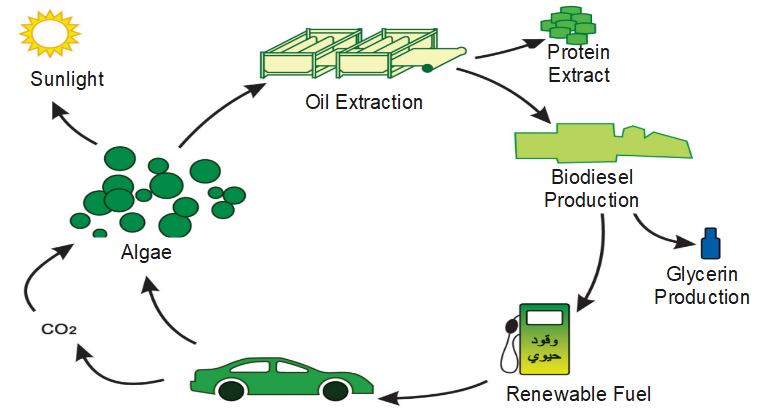
Algae
Algae, whose most familiar form is seaweed, produces energy through photosynthesis at a much quicker rate than any other biofuel feedstock. Algae can be grown in ocean water, so it does not deplete freshwater resources. It also does not require soil, and therefore does not reduce arable land that could potentially grow food crops. Although algae releases carbon dioxide when it is burned, it can be farmed and replenished as a living organism. As it is replenished, it releases oxygen, and absorbs pollutants and carbon emissions.
Algae contains oils that can be converted to a biofuel. This creates a ‘green crude’, which has similar properties to crude oil, and can be used as a biofuel.
The advantages of biomass
There are some important advantages of using biomass:
- Biomass is a clean, renewable energy source. Its initial energy comes from the sun, and plants or algae biomass can regrow in a relatively short amount of time. Trees, crops, and municipal solid waste are consistently available and can be managed sustainably.
- If trees and crops are sustainably farmed, they can offset carbon emissions when they absorb carbon dioxide through respiration. In some bioenergy processes, the amount of carbon that is re-absorbed even exceeds the carbon emissions that are released during fuel processing or usage. Many biomass feedstocks, such as switchgrass, can be harvested on marginal lands or pastures, where they do not compete with food crops.
- Unlike other renewable energy sources, such as wind or solar, biomass energy is stored within the organism, and can be harvested when it is needed.
The disadvantages of biomass
There are several advantages of using biomass:
- If biomass feedstocks are not replenished as quickly as they are used, they can become non-renewable. A forest, for instance, can take hundreds of years to re-establish itself.
- Most biomass requires arable land to develop. This means that land used for biofuel crops such as corn and soybeans are unavailable to grow food or provide natural habitats. Biomass fuels also require watering to grow so they are not an ideal source of energy in water scarce countries.
- Forested areas that have matured for decades are able to sequester more carbon than newly planted areas. Therefore, if forested areas are not sustainably cut, re-planted, and given time to grow and sequester carbon, the advantages of using the wood for fuel are not offset by the trees’ regrowth.
- Biomass has a lower ‘energy density’ than fossil fuels. As much as [latex]\scriptsize \displaystyle 50\%[/latex] of biomass is water, which is lost in the energy conversion process. Scientists and engineers estimate that it is not economically efficient to transport biomass more than [latex]\scriptsize \displaystyle 160[/latex] kilometres from where it is processed. However, converting biomass into pellets as opposed to wood chips or larger briquettes can increase the fuel’s energy density and make it more advantageous to ship.
- Burning biomass releases carbon monoxide, carbon dioxide, nitrogen oxides, and other pollutants and particulates. If these pollutants are not captured and recycled, burning biomass can create smog and even exceed the number of pollutants released by fossil fuels.
Note
To consolidate your knowledge of renewable energy, you can watch this video 7 Types of Renewable Energy by EcoMastery Project.
| Energy resource | Energy store | Renewable or non-renewable | Uses | Power output | Impact on environment |
| Fossil fuels (oil, coal, and natural gases) | Chemical | Non-renewable | Transport, heating, electricity generation | High | Releases CO2 (causes global warming) |
| Nuclear fuels | Nuclear | Non-renewable | Electricity generation | Very high | Radioactive waste (needs to be disposed of safely) |
| Biofuel | Biofuel | Renewable | Transport, heating, electricity generation | Medium | ‘Carbon neutral’ – little or no effect on the environment. Although growing biofuels can take up land that could be used for farming. |
| Wind | Kinetic | Renewable | Electricity generation | Very low | Takes up large areas that could be used for farming; windmills change the landscape |
| Hydroelectricity | Gravitational potential | Renewable | Electricity generation | Medium | Local habitats are affected by the large areas that need to be flooded to build dams |
| Geothermal | Internal (thermal) | Renewable | Electricity generation, heating | Medium | Very low |
| Tides | Kinetic | Renewable | Electricity generation | Potentially very high, but hard to harness | Tidal barrages can block sewage which needs to go out to sea; local habitats also affected |
| Sun | Nuclear | Renewable | Electricity generation, heating | Dependent on the weather and only available during daylight | Very little |
| Water waves | Kinetic | Renewable | Electricity generation | Low | Very low |
Exercise 1.2
- Which of the following groups are all renewable energy sources?
- The tides, water waves and nuclear fuel
- Biofuel, geothermal and coal
- Geothermal, the tides and hydroelectricity
- A learner suggests replacing a coal power station with solar panels on the same site. Give two reasons why this might not be good idea.
- Give three ways of generating electricity in which no fuel is burned, and the energy is renewable.
- Petrol and ethanol are both fuels. Petrol is made from oil. Oil could run out in 100 years.
In some countries people plant sugar cane and use it to make ethanol, which can be used as a fuel for transportation.- What type of renewable fuel is sugar cane?
- Sugar cane will not run out. Explain why.
The full solutions are at the end of the unit.
Electrochemical cells
A fuel cell can be defined as an electrochemical cell that generates electrical energy from fuel via an electrochemical reaction. These cells require a continuous input of fuel and an oxidising agent (generally oxygen) to sustain the reactions that generate the electricity. Therefore, these cells can constantly generate electricity until the supply of fuel and oxygen is cut off.
Despite being invented in the year 1838, fuel cells began commercial use when NASA used them to power space capsules and satellites. Today, these devices are used as the primary or secondary source of power for many facilities including industries, commercial buildings, and residential buildings.
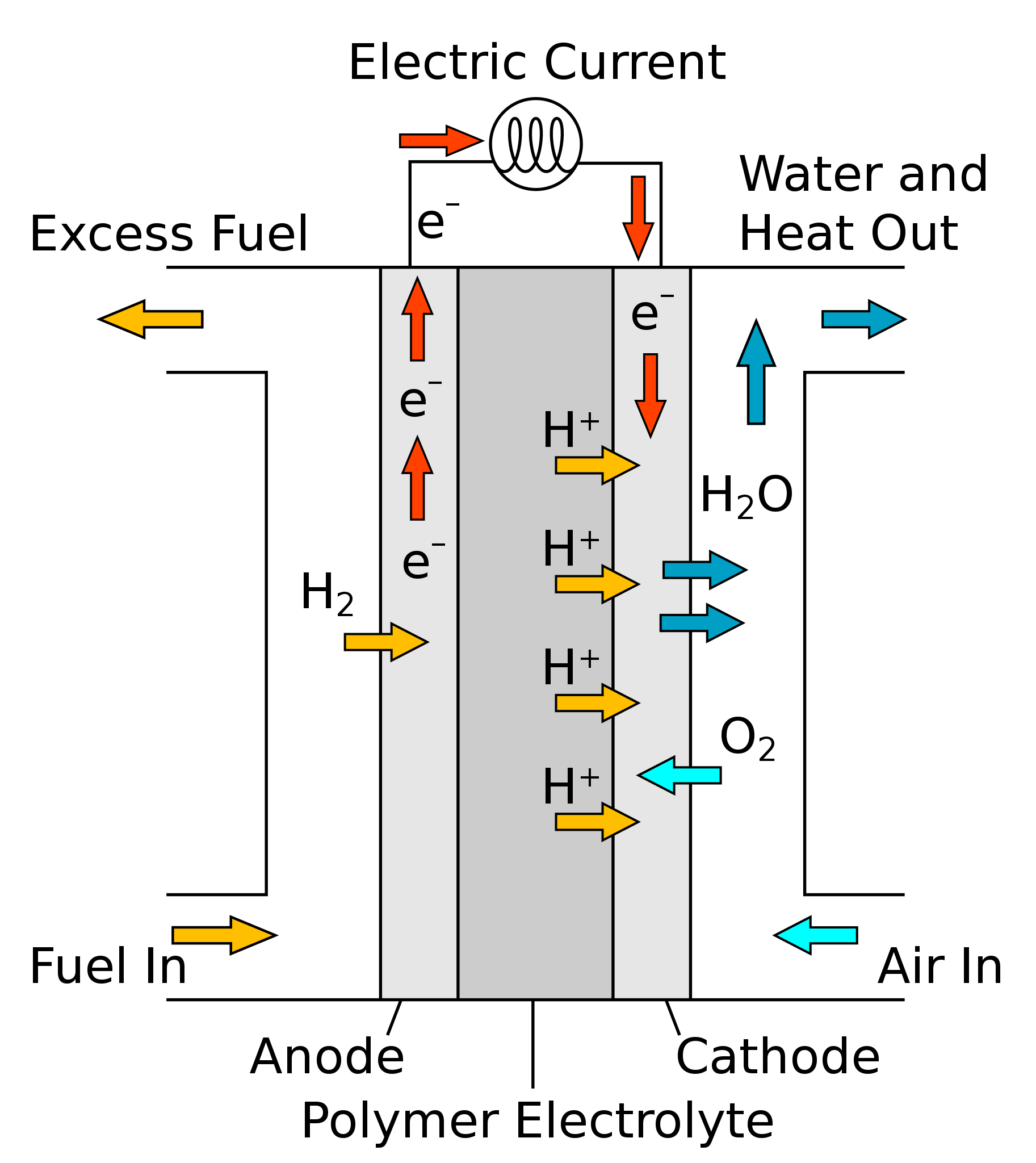
The reaction between hydrogen and oxygen can be used to generate electricity via a fuel cell. Such a cell was used in the Apollo space programme, and it served two different purposes – It was used as a fuel source as well as a source of drinking water (the water vapour produced from the cell, when condensed, was fit for human consumption).
The working of this fuel cell involved the passing of hydrogen and oxygen into a concentrated solution of sodium hydroxide via carbon electrodes. The cell reaction can be written as follows:
Cathode reaction: [latex]\scriptsize \displaystyle {{\text{O}}_{\text{2}}}\text{ + 2}{{\text{H}}_{\text{2}}}\text{O + 4}{{\text{e}}^{\text{--}}}\to \text{4O}{{\text{H}}^{\text{--}}}[/latex]
Anode reaction: [latex]\scriptsize \displaystyle \text{2}{{\text{H}}_{\text{2}}}\text{ + 4O}{{\text{H}}^{\text{--}}}\to \text{4}{{\text{H}}_{\text{2}}}\text{O + 4}{{\text{e}}^{\text{--}}}[/latex]
Net cell reaction: [latex]\scriptsize \displaystyle \text{2}{{\text{H}}_{\text{2}}}\text{ + }{{\text{O}}_{{\text{2 }}}}\to \text{2}{{\text{H}}_{\text{2}}}\text{O}[/latex]
However, the reaction rate of this electrochemical reaction is quite low. To overcome this issue, a catalyst such as platinum or palladium is used. To increase the effective surface area, the catalyst is finely divided before being incorporated into the electrodes.
The efficiency of the fuel cell described above in the generation of electricity generally approximates to [latex]\scriptsize \displaystyle 70\%[/latex] compared to the efficiency of thermal power plants at [latex]\scriptsize \displaystyle 40\%[/latex]. This difference is because the generation of electric current in a power plant involves the conversion of water into steam, and the usage of this steam to rotate a turbine. Fuel cells, however, directly convert chemical energy into electrical energy.
The Department of Science and Technology, wants South Africa to achieve [latex]\scriptsize 25 \%[/latex] of the global market in the production of hydrogen and fuel cell catalysts, using platinum group metal catalysts. With platinum being a key component for most fuel cells, the country is well placed to do so, particularly as it has three quarters of the world’s platinum reserves.
Types of fuel cells
There are several varieties of fuel cells:
The Polymer Electrolyte Membrane (PEM) Fuel Cell used for transport and stationary and portable generation of power.
The Solid Acid Fuel Cell which uses solid acids including caesium hydrogen sulfate and caesium dihydrogen phosphate respectively.
The Alkaline Fuel Cell which uses an aqueous alkaline solution. These cells are highly efficient. They also produce heat and water along with electricity.
The Solid Oxide Fuel Cell uses a solid oxide or a ceramic electrolyte. These fuel cells are highly efficient and have a relatively low cost.
The Molten Carbonate Fuel Cell uses lithium potassium carbonate salt. These cells can be powered by carbon-based fuels such as natural gas and biogas.
Applications of fuel cells
There are a number of applications of fuel cells:
- Power: Stationary fuel cells are used for commercial, industrial, and residential primary and backup power generation. Fuel cells are very useful as power sources in remote locations, such as spacecraft, remote weather stations, large parks, communications centres, rural locations, and in certain military applications. A fuel cell system running on hydrogen can be compact and lightweight and have no major moving parts. Because fuel cells have no moving parts and do not involve combustion, in ideal conditions they can achieve up to [latex]\scriptsize 99.9999 \%[/latex] reliability.
- Co-generation: Combined heat and power (CHP) fuel cell systems, including micro combined heat, power office building and factories. The system generates constant electric power (selling excess power back to the grid when it is not consumed), and at the same time produces hot air and water from the waste heat. The waste heat from fuel cells can be diverted during summer directly into the ground providing further cooling while the waste heat during winter can be pumped directly into the building.
- Fuel cell electric vehicles (FCEVs): A fuel cell vehicle (FCV) or fuel cell electric vehicle (FCEV) is an electric vehicle that uses a fuel cell, sometimes in combination with a small battery or supercapacitor, to power its onboard electric motor. Fuel cells in vehicles generate electricity generally using oxygen from the air and compressed hydrogen. Most fuel cell vehicles are classified as zero-emission vehicles that emit only water and heat.
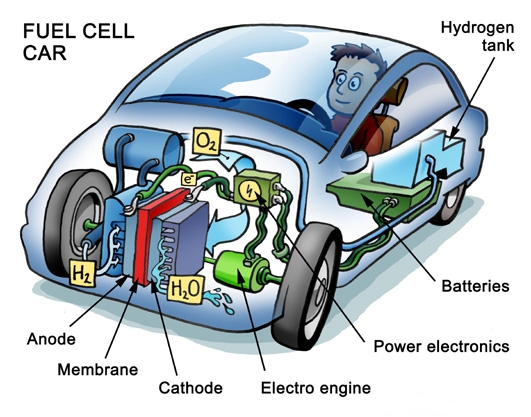
Figure 19: Fuel cell electric vehicles, or FCEVs, use clean fuels and are therefore more eco-friendly than internal combustion engine-based vehicles .
This technology is also being used to power buses, forklifts, motorcycles, boats, and aeroplanes.
.
These vehicles differ from electric vehicles, which use rechargeable batteries. - Portable power systems: As power demands for cell phones increase, fuel cells could become much more attractive options for larger power generation. The demand for a longer battery life for mobile phones and computers is something often demanded by consumers so fuel cells could start to make strides into laptop and cell phone markets.
.
Fuel cells for use in larger scale operations also show much promise. Portable power systems that use fuel cells can be used in the leisure sector, the industrial sector (i.e. power for remote locations including gas/oil well sites, communication towers, security, weather stations), and in the military sector. The key advantage of fuel cells in this market is the great power generation per weight. While fuel cells can be expensive, for remote locations that require dependable energy, fuel cells provide efficient power solutions.
The advantages of fuel cells
Fuel cells have several advantages:
- Renewable and readily available: Hydrogen is the most abundant element in the Universe and despite the challenges associated with its extraction from water, it is a uniquely abundant and renewable source of energy.
- Hydrogen is a clean and flexible energy source to support zero-carbon energy strategies:
Hydrogen fuel cells provide an inherently clean source of energy, with no adverse environmental impact during operation as the by-products are simply heat and water (which you can drink). Hydrogen fuel cells do not generate greenhouse gas emissions like fossil fuel sources, thus reducing pollution and improving air quality as a result. - More powerful and energy efficient than fossil fuels: Hydrogen fuel cell technology provides a high-density source of energy with good energy efficiency. Hydrogen fuel cells are more efficient than many other energy sources, including many green energy solutions.
- Fast charging times: The charge time for hydrogen fuel cell power units is like that for conventional internal combustion engine vehicles and much quicker in comparison to electric vehicles which can take several hours to charge, hydrogen fuel cells can be recharged in under five minutes.
- No noise pollution
- Long usage times: A hydrogen vehicle has the same range as those that use fossil fuels.
- Ideal for use in remote areas: The availability of hydrogen through local generation and storage could prove to be an alternative to diesel-based power and heating in remote areas.
- Democratisation of power supply: Hydrogen fuel cells have the potential to reduce the dependency of a nation on fossil fuels, which will help democratise energy and power supplies around the world. This increased independence will prove a benefit for many countries who are currently reliant on fossil fuel supply.
The disadvantages of fuel cells
There are some notable disadvantages to using fuel cells:
- Hydrogen extraction: Despite being the most abundant element in the Universe, hydrogen does not exist on its own so needs to be extracted from water via electrolysis or separated from carbon fossil fuels. Both processes require a significant amount of energy to achieve. In addition, this extraction typically requires the use of fossil fuels, which reduces the green credentials of hydrogen.
- Investment is required: Hydrogen fuel cells need investment to be developed to the point where they become a genuinely viable energy source.
- Cost of raw materials: Precious metals such as platinum and iridium are typically required as catalysts in fuel cells and some types of water electrolyser, which means that the initial cost of fuel cells can be high. This high cost has deterred some from investing in hydrogen fuel cell technology.
- Overall cost: The cost for a unit of power from hydrogen fuel cells is currently greater than other energy sources, including solar panels.
- Hydrogen storage and transportation: Hydrogen is a highly flammable fuel source, which brings understandable safety concerns. Hydrogen gas burns in air at concentrations ranging from [latex]\scriptsize 4 \%[/latex] to [latex]\scriptsize 75 \%[/latex]. Storage and transportation of hydrogen is more complex than that required for fossil fuels. This implies additional costs to consider for hydrogen fuel cells as a source of energy.
- Infrastructure: Because fossil fuels have been used for decades, the infrastructure for this power supply already exists. Large scale adoption of hydrogen fuel cell technology for vehicles will require new refuelling infrastructure to support it.
Note
To further understand fuel cells you can watch this video called Hydrogen & Fuel Cells by Fuse Schools.
Exercise 1.3
- True or false: A fuel cell is a type of electrochemical cell?
- Which of the following can be used as fuel in a fuel cell?
- Nitrogen
- Helium
- Carbon
- Hydrogen
- Which of the following is not produced by a fuel cell?
- Electricity
- Greenhouse gases
- Heat
- Water
- Which of the following statements are false:
- Hydrogen is highly flammable.
- Fuel cells do not need refuelling and will not run out of generating capacity.
- The cost of the catalysts used is very high.
- Fuel cells do not cause pollution.
The full solutions are at the end of the unit.
Summary
In this unit you have learnt the following:
- Sources of energy can be renewable or non-renewable.
- Non-renewable sources of energy are fossil fuels (coal, oil and gas) and nuclear.
- Coal, oil and gas are burnt to release energy to generate electricity and power vehicles.
- Burning fossil fuels releases greenhouse gases which contribute to climate change and gases which contribute to acid rain.
- Nuclear energy uses uranium as a fuel.
- Nuclear energy is very efficient and does not release greenhouse gases or gases which contribute to acid rain.
- Renewable sources of energy will not run out.
- Renewable sources of energy include wind and solar.
- Renewable sources of energy do not release greenhouse gases or gases which contribute to acid rain.
Unit 1: Assessment
Suggested time to complete: 30 minutes
- Which of these is a non-renewable energy resource?
- Coal
- Geothermal
- Wind
- What does wind directly turn to generate electricity?
- Generator
- Motor
- Turbine
- Which of these is an advantage of wind energy?
- There is no electricity when there is no wind
- No harmful gases are produced
- Turbines may be noisy
- Which of these is a disadvantage of hydroelectric power?
- It is very reliable
- Dams destroy the habitats of estuary species
- There are no fuel costs
- Which type of energy does not come from the Sun?
- Biomass
- Wind
- Geothermal
- Which of these is a disadvantage of geothermal energy?
- Power stations can only be built in certain areas
- It is renewable
- No harmful gases are produced
- What do photovoltaic panels generate?
- Electricity
- Steam
- Hot water
- Which of these is a disadvantage of photovoltaic panels?
- They are renewable
- They do not work at night
- They only heat water slowly
- Where does the energy come from in geothermal power stations?
- Fuel
- The Sun
- The Earth’s hot core
- The national grid is supplied with electricity from large-scale electrical generators. These generators may be driven using different energy sources. Compare the use of a non-renewable energy source with the use of a renewable energy source to produce electricity for the national grid.
- Wind energy requires significant amounts of empty land where wind blows regularly. Suppose a proposal is made to turn most of the Western and Eastern Cape into a gigantic wind farm. Would you support the proposal? Please justify your answer.
- Imagine you were the Minister for Environmental Affairs, and the President has asked you to reduce the amount of fossil fuels used in South Africa. Which methods would you use to generate electricity in South Africa? Justify your answer.
The full solutions are at the end of the unit.
Unit 1: Solutions
Exercise 1.1
- Advantage: energy efficient, cleaner than fossil fuels, low running costs, fuel costs are low.
Disadvantages: disposal/storage of radioactive waste, potential for radioactive disaster! - Non-renewable sources of energy, burning them emits pollutants which contribute to global warming.
- .
- abundant supplies of coal
- infrastructure to generate electricity
- cheap fuel.
Exercise 1.2
- c
- Solar panels will not provide a consistent supply of energy as the coal power station does. The amount of energy supplied by the solar panels per hour will be much lower than the amount supplied by the coal power station.
- any 3 of the following:
- solar
- wind
- geothermal
- hydroelectric
- wave
- tidal
- .
- biomass
- Sugar cane can be replanted again and again.
Exercise 1.3
- True
- d
- b
- b
Unit 1: Assessment
- a
- c
- b
- b
- c
- a
- a
- b
- c
- First, you should write down the two energy sources you have chosen, and say which is renewable and which is non-renewable, e.g. ‘Wind is a renewable energy source. Coal is a non-renewable energy source’. Then comment on at least two similarities and two differences between the energy sources.
.
Fossil fuel power stations are cheaper to build than wind farms for the same power output. However, fossil fuel power stations produce [latex]\scriptsize \displaystyle \text{C}{{\text{O}}_{\text{2}}}[/latex] which may increase global warming – renewable energy generators (wind farms) do not.
.
Renewable energy generators have a free or cheaper source of fuel.
.
Fossil fuels must be taken out of the ground.
.
Nuclear power stations produce radioactive waste, which is dangerous, none of the other energy generators do this.
.
Wind, waves, and sun are unreliable sources of energy, but fossil and nuclear fuels are always available. - Either ‘yes you would approve the proposal’ or ‘no you wouldn’t’ needs to be stated and then reason given for your choice.
.
…….. No:- Affects bird populations.
- Wind is not reliable.
- Wind turbines cause visual pollution and noise pollution – there is a large tourist industry in the Western Cape which would be affected by the sight and noise of the turbines.
- Wind farms may destroy landscapes and habitats, as trees need to be removed to build the turbines.
- Wind turbines are expensive.
.
Yes: - Renewable source of energy.
- Does not release polluting gases, so does not contribute to climate change.
- Farmers can still farm below the turbines.
- Fuel costs are zero because the wind is free.
- Low maintenance costs of the turbines.
- Any renewable source is fine, but remember to justify your answer:
.
Solar: The abundance of sunshine in South Africa (makes this the best choice). Large parts of the Northern Cape and the Karoo are uninhabited, so there is lots of space. Cities and towns could have solar panels installed on roof tops, and in parking lots to allow for solar farms. It is a clean, and renewable source of energy. Once the farms have been set up, the fuel is free. Little maintenance costs, no pollutants and in areas such as the Northern Cape and the Karoo there are very few days in a year when it is cloudy, so it is a reliable source of energy.
.
Wind: Renewable source of energy
Does not release polluting gases, so does not contribute to climate change.
Farmers can still farm below the turbines.
Fuel costs are zero because the wind is free.
Low maintenance costs of the turbines.
.
Nuclear: South Africa has an abundant supply of Uranium although it is a non-renewable source of energy. Maintenance costs once the power stations have been built are low. It is an efficient and reliable source of energy. Does not need as much space as a solar or wind farm and is a cleaner fuel than using fossil fuels.
.
Biomass: not really an option for SA because this is a water scarce country.
Geothermal: can be used but is extremely expensive. Hydroelectricity: can be used, but there are cheaper, more efficient, more environmentally friendly options available.
Media Attributions
- Fig 1 © DHET is licensed under a CC BY (Attribution) license
- Fig 2 © Peace01234 is licensed under a CC BY-SA (Attribution ShareAlike) license
- Fig 3 © DHET is licensed under a CC BY (Attribution) license
- Fig 4 © How much is licensed under a All Rights Reserved license
- Fig 5 © Duke Energy is licensed under a CC BY-NC-ND (Attribution NonCommercial NoDerivatives) license
- Fig 6 © energy.org is licensed under a All Rights Reserved license
- Fig 7 © energy.org is licensed under a Public Domain license
- Fig 8 © The World Bank is licensed under a CC BY (Attribution) license
- Fig 9 © Htxt is licensed under a Public Domain license
- Fig 10 © Av afloresm is licensed under a CC BY (Attribution) license
- Fig 11 © Planet Labs is licensed under a CC BY-SA (Attribution ShareAlike) license
- Fig 12 © Fran Van Heerden is licensed under a CC0 (Creative Commons Zero) license
- Fig 13 © Rfassbind is licensed under a Public Domain license
- Fig 14 © DHET is licensed under a CC BY (Attribution) license
- Fig 15 © DHET is licensed under a CC BY (Attribution) license
- Fig 16 © Muhammad Rizwan Javed is licensed under a CC BY-SA (Attribution ShareAlike) license
- Fig 17 © DHET is licensed under a CC BY (Attribution) license
- Fig 18 © Albris is licensed under a Public Domain license
- Fig 19 © Welleman is licensed under a Public Domain license
